Step right up, folks! Ever wondered if your feet were secretly whispering health secrets that your doctor missed? Turns out, those humble footsies might just be the tell-all tabloids of your well-being. From toe wiggles to arch quirks, join us in this podiatric detective story where every step is a clue and each callus tells a tale. Get ready to decode the language of your soles because, let's face it, your feet are the unsung heroes carrying the weight of your health secrets!
1. Toe Nails With Slightly Sunken Indentations
Sunken toenails with indentations may indicate underlying health issues. While chronic iron deficiency or anemia is a common cause, other factors like high altitude, trauma or exposure to petroleum products can contribute to concave toenails.
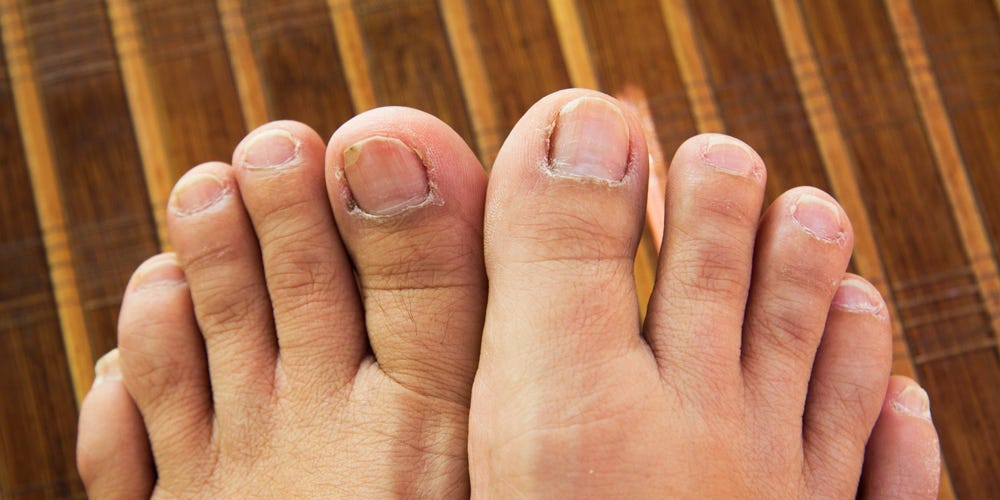
Image source/womenshealthConsult with a doctor if you notice any abnormalities. Persistent concave toenails may warrant a thorough medical examination to identify the root cause and implement appropriate interventions. Any concerns related to nail abnormalities should be addressed.Original content sourced from Femanin.com
2. Hairless Feet Or Toes
Hair loss on the feet or toes can indeed be a potential sign of peripheral artery disease (PAD). Peripheral artery disease is a condition where there is a build up of fatty deposits and plaque in the arteries, usually in the legs and feet, restricting blood flow.
Image source/redditThe reduced blood flow can lead to various symptoms, including hair loss on the feet or toes. Other symptoms of PAD may include leg pain or cramping during physical activity, numbness or weakness and slow-healing sores or wounds. It's actually not uncommon in middle aged Americans.
3. Frequent Foot Cramping
Frequent foot cramping can be caused by a number of factors and it is important to consider the different potential causes. These could include inadequate fluid intake (dehydration) which can lead to electrolyte imbalances, leading on to the cramping.
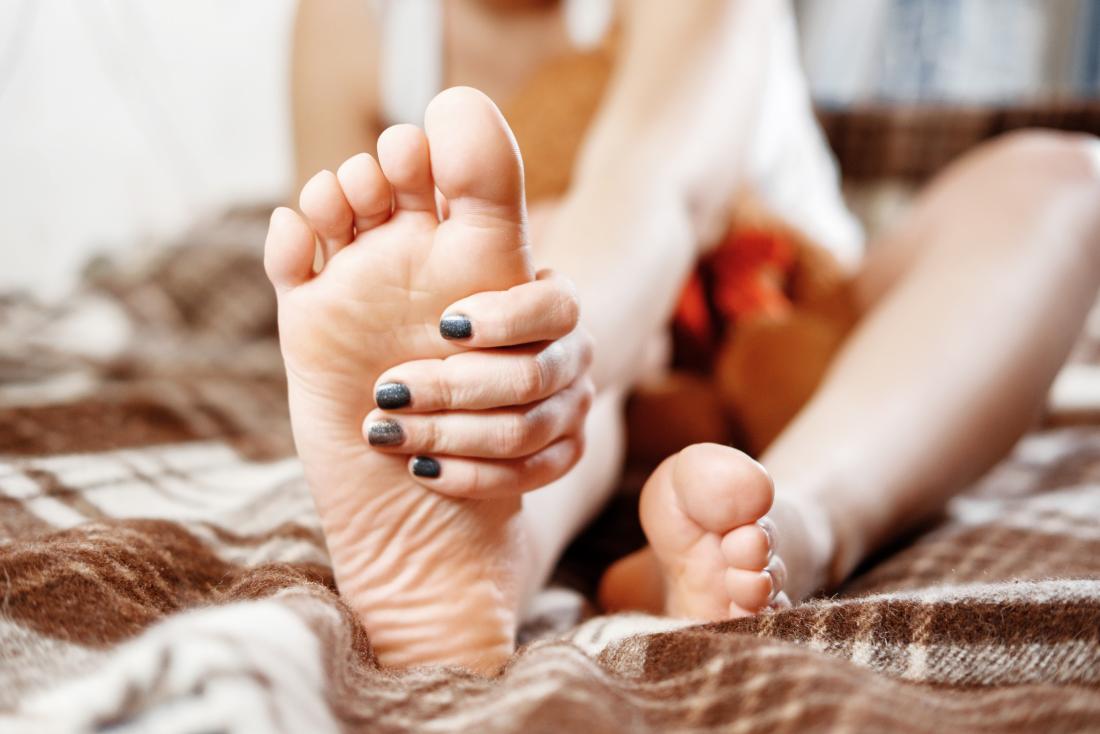
Image source/medicalnewstodayInsufficient levels of minerals like potassium, magnesium or calcium may also result in foot cramping. On a more serious note, underlying medical conditions such as diabetes, hypothyroidism or neurological disorders can contribute to uncomfortable foot cramping.
4. Sores That Won't Heal
People who are diagnosed with diabetes are at risk of foot complications and poor circulation. Nerve damage can also contribute to slow wound healing. It can affect sensation in the feet, making individuals less aware of injuries and hindering the healing process.
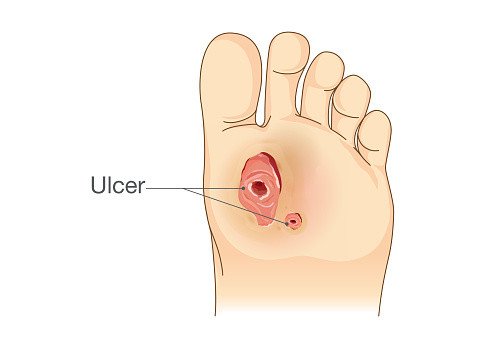
Image source/drugs.comChronic or deep-seated infections in the feet can also impede the healing process as can certain autoimmune conditions. If someone has persistent sores on their feet, it's crucial to seek medical attention promptly. A healthcare professional, often a podiatrist, can advise.
5. Constant Cold Feet
If you're over 40, you could have a sluggish thyroid without knowing it, so if you're constantly struggling to warm your feet up, then this could be the issues. Hyperthyroidism can also cause hair loss, fatigue, unexplained weight gain and depression too.
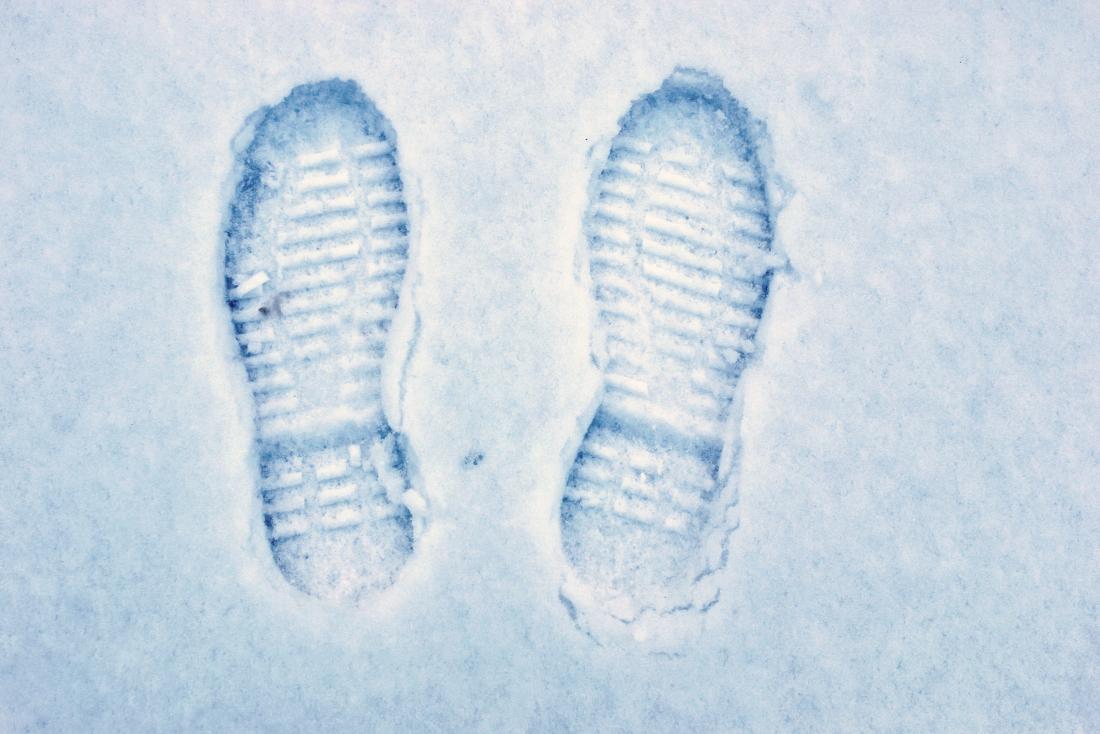
Image source/medicalnewstodaySurprisingly, chronic stress can lead to vasoconstriction, reducing blood flow to the feet and causing coldness. Raynaud's Disease, in rarer cases, causes blood vessels to narrow in response to cold or stress, affecting blood flow to the extremities, another condition for constant cold feet.
6. Thick, Yellow, Downright Toenails
Signs of a fungal infection are thick, yellow, downright toenails. People with autoimmune diseases are more at risk of developing fungal infections if they're taking immunosuppressant medications. Other medications can also increase the risk of developing fungal infections too.
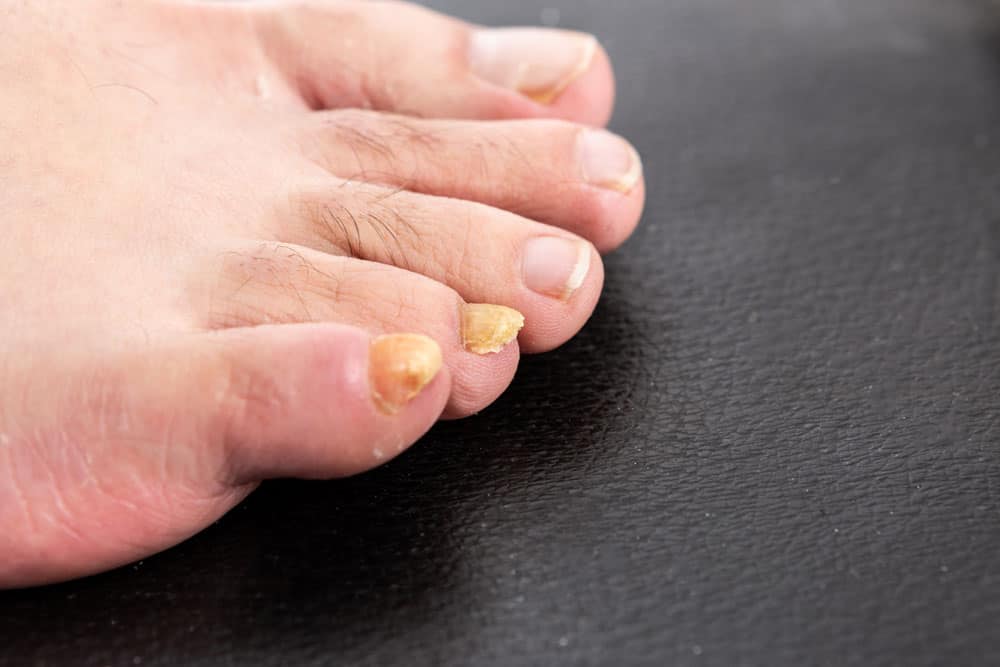
Image source/preferredfootandankleclinicCertain skin conditions, like eczema, can extend to the nails and cause changes. Your age can also be the reason as normal aging processes can lead to changes in the nails, including thickening. Finally, trauma damage to the toenail can result in thickening and discoloration.
7. Numbness In Both Feet
Peripheral neuropathy or a pinched nerve could be the reason why you're experiencing numbness in your little trotters. If you're experiencing neuroma, or numbness in only one foot, you could just have a pinched nerve. likely caused by years of wearing tight shoes.

Image source/certifiedfootandankleclinicLack of essential nutrients such as vitamin B12 or folate can be contributory factors towards peripheral neuropathy. Also, excessive alcohol consumption can lead to a variety of symptoms including nerve damage and numbness in both feet. Seek help and don't suffer.
8. Stiff, Sore Toe Joints
Gout is a form of arthritis caused by the accumulation of uric acid crystals in the joints, often affecting the big toe. This can lead to sudden and severe pain, swelling, and stiffness. Bunions, bony bumps that form on the joint at the base of the big toe may be the cause of sore toe joints.
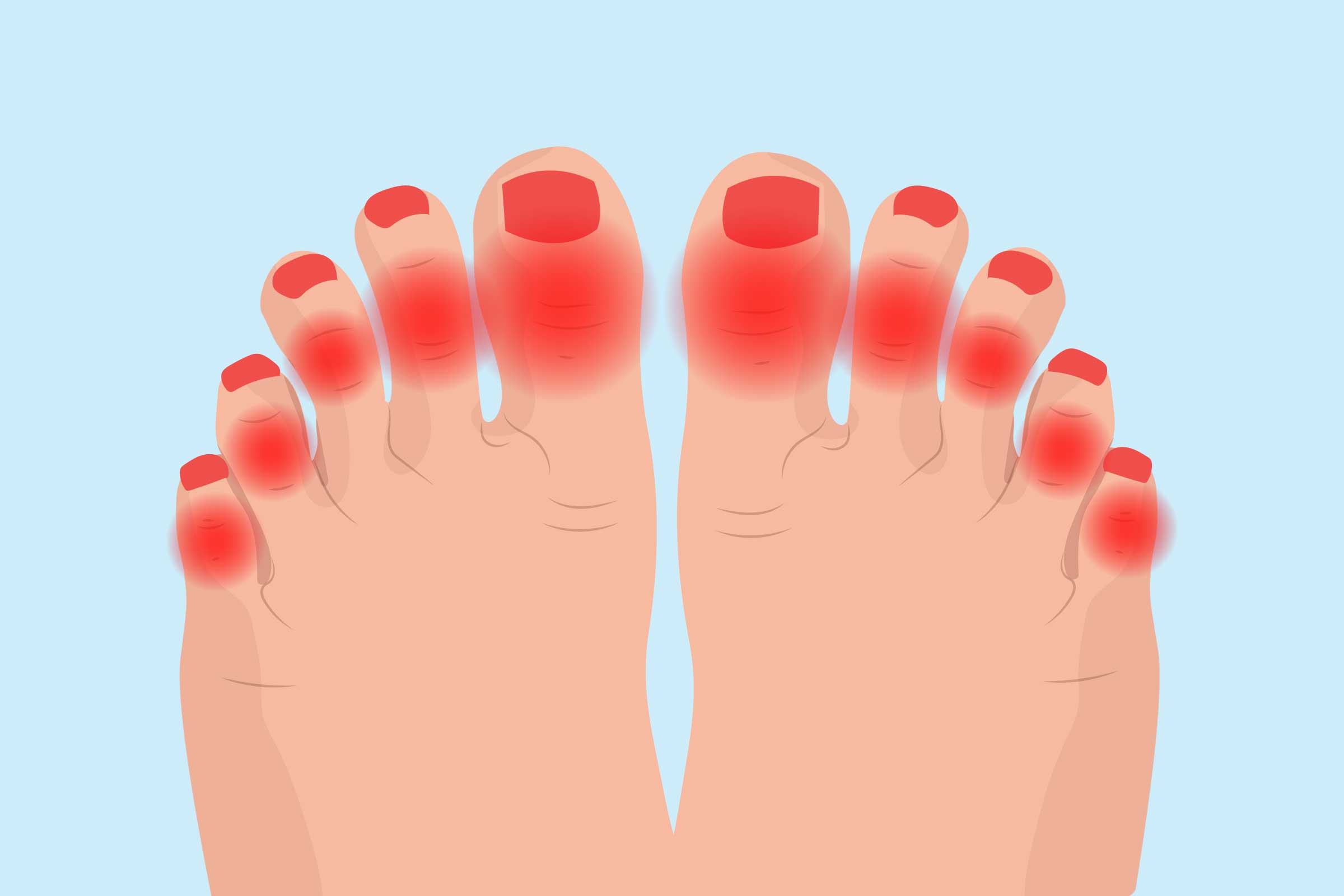
Image source/creakyjointsAccording to John Hopkins Medicine, signs of rheumatoid arthritis typically start in the small joins or the hands and feet. If you have persistent achiness or swelling, talk to your doctor about seeing a rheumatologist. It's always better to get a consultation sorted out.
9. Dry, Flaky Feet
Athlete's foot can cause dryness, flakiness and itching on the feet. Fungal infections thrive in moist environments, such as sweaty feet in tight shoes. Certain conditions, such as diabetes, thyroid disorders or circulatory problems can affect skin health and contribute to dryness.
:max_bytes(150000):strip_icc()/iStock-670950774-58ff78db5f9b581d594b02f5-969c69c3b29f41d5a163384cf41e86bf.jpg)
Image source/verywellhealthWhen thyroid hormone levels are low, it can affect the skin's ability to stay hydrated and maintain its natural moisture. Dry skin is a common symptom of hypothyroidism, and this dryness can extend to the feet. This hormones play a crucial role in regulating skin health.
10. A Painful, Enlarged Toe Nail
An enlarged, painful toe nail could be as a result of an ingrowing toe nail. This can occur when the edge of the toenail grows into the surrounding skin, causing pain, redness, and swelling. Ingrown toenails can be caused by improper nail trimming, tight shoes or genetic factors.
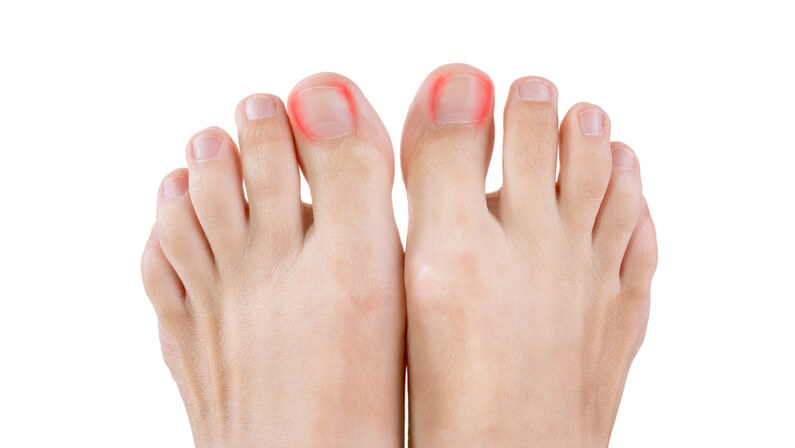
Image source/rapidcareemergencyroomThere is a condition called paronychia, an infection of the skin around the nail. It can be caused by bacteria or fungi and may result from ingrown toenails or other types of trauma and can be very painful. As with finger nails, any change in nail appearance should not be ignored.
11. Red Lines Under Your Toenail - Usually Small Ones
Physical trauma to the toes or toenails, such as stubbing your toe or dropping something heavy on it, can cause bleeding underneath the nail bed, leading to the appearance of red lines. So can nail disorders, such as psoriasis or lichen planus which can cause the lines.

Image source/clevelandclinicSmall red lines under the toe nail could be broken blood vessels known as splinter haemorrhages but it can also be a sign of endocarditis which is an infection of the heart's inner lining. So if you notice little splinters and you haven't experienced any trauma to the nail, then keep an eye on it.
12. Clubbing Of The Nail
The symptom of clubbing is often associated with lung cancer, chronic lung infection or heart conditions caused by birth defects or infection of the lining of the heart valves. Clubbing occurs when there's a lower amount of oxygen in the blood which causes rounder, wider fingers and toes.

Image source/wikipediaIt's important to note that nail clubbing is not a disease in itself but a clinical sign that suggests an underlying medical condition. If you observe changes in the shape and appearance of your nails, particularly if you notice clubbing, it's crucial to seek medical attention.
13. Pits In Your Nails
If you find little grooves or ridges in your toenails, you may have nail psoriasis (an autoimmune disease that makes skin patchy and irritated). 5% of the population with nail psoriasis do not feel the affects elsewhere on their body. Other symptoms include white patches and horizontal lines across the nails.
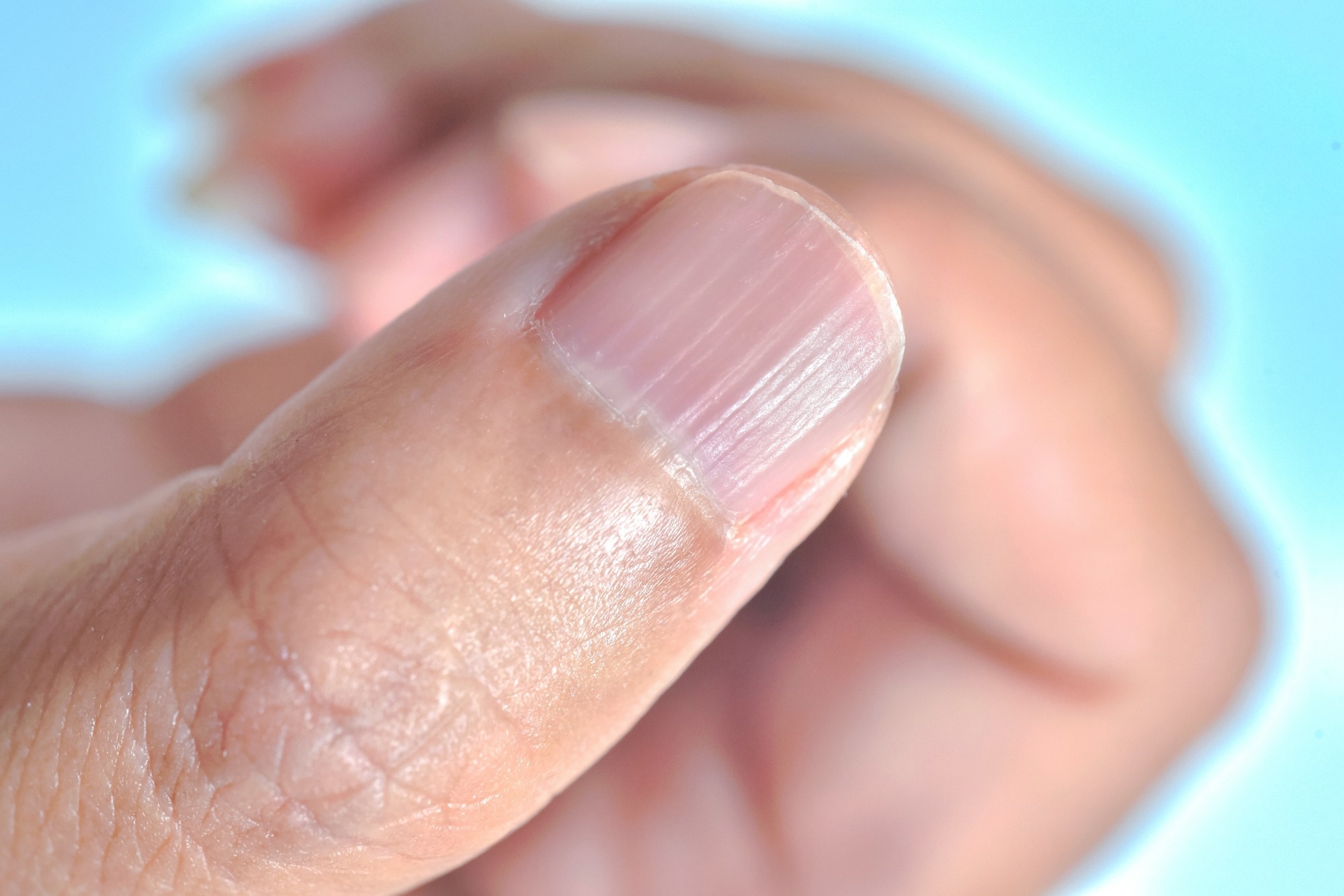
Image source/newsmedicalCertain connective tissue disorders, such as systemic lupus erythematosus (SLE), can be associated with nail changes, including pitting. You probably weren't aware that alopecia areata, a condition that
primarily affects hair follicles, can also cause changes in the nails, including pitting.
14. Bunions. Bunions. BUNIONS
Bunions are bony bumps that develop on the joint at the base of the big toe. The medical term for this condition is "hallux valgus." Bunions form when the big toe pushes against the adjacent toe, forcing the joint of the big toe to get bigger and stick out.

Image source/peninsulaorthopedicOver time, the abnormal positioning of the big toe joint can lead to quite severe pain, inflammation and sometimes difficulty in finding comfortable footwear. Surgery is the only answer to getting rid of bunions for good and it's a 4-6 week recovery process.
15. Yellow Toe Nails Can Be A Sign Of Fungus Or Pedicure Overloads
Although possibly a sign of fungus or damage from a pedicure, yellowness can happen naturally with age. If you also have brittle nails and some flaking, it's likely to be a fungal infection like athlete's foot which is easy to get rid of with over the counter medication.
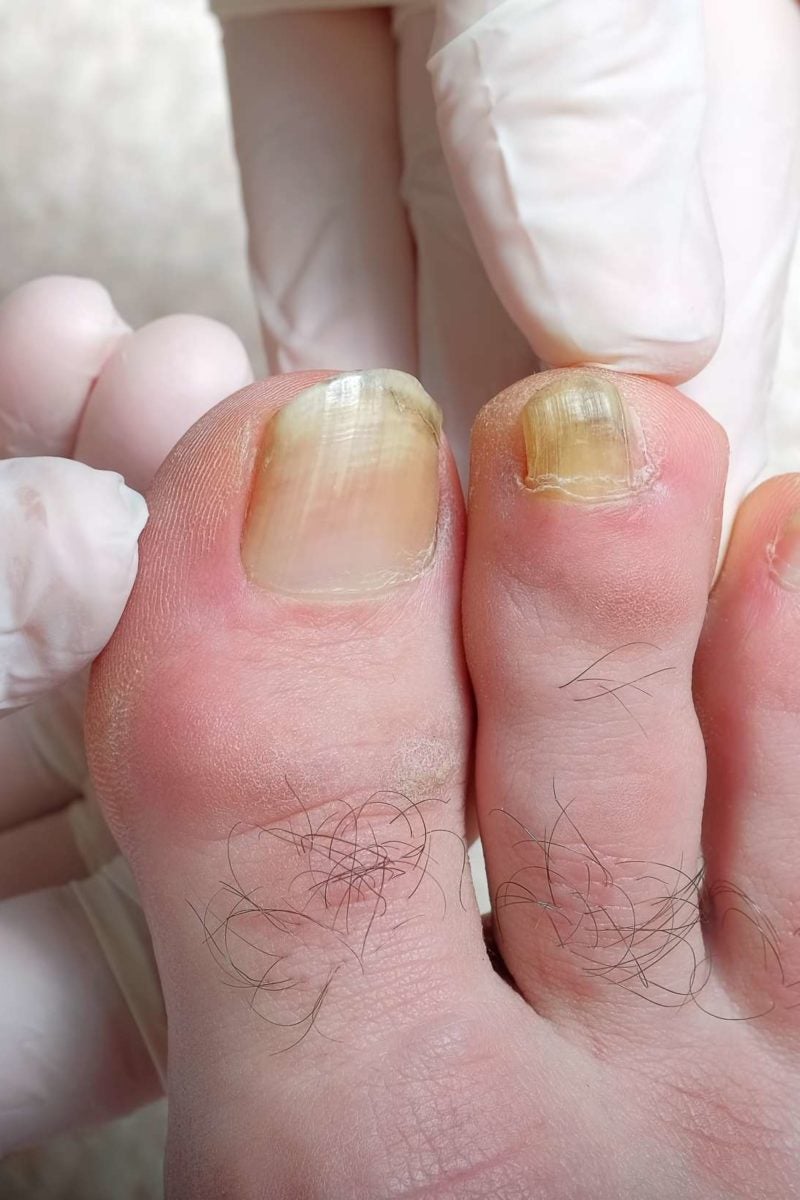
Image source/medicalnewstodayRegular nail care, wearing comfortable, breathable shoes and maintaining proper foot hygiene can all contribute to overall nail health. If concerns persist, seeking advice from a healthcare professional ensures an accurate diagnosis and appropriate treatment.
16. The Inability To Lift The Front Part Of Your Foot
The paralysis or weakness of the muscles that lift the food cause the inability to lift the front part of your foot. This could be a sign of a number of underlying disorders like neurodegenerative disorders, MS, stroke, cerebral palsy, polio and ALS as well as other muscle or nerve disorders.

Image source/danpreecePrompt medical evaluation is crucial for an accurate diagnosis, as underlying conditions require tailored treatments, including physical therapy, orthotic devices and surgery. Early intervention improves the prognosis and enhances the quality of life for individuals experiencing foot drop.
17. Your Toes Are Red or Blue
Now we've all heard of Raynaud's disease which is a disorder of the blood vessels supplying certain parts of the body like the toes and fingers that become numb and turns blue when exposed to cold temperatures. This can occur when you are under stress.

Image source/medicalnewstodayWhile cold exposure is a well-known trigger, it's important to note that stress, both physical and emotional, can also induce Raynaud's episodes. The physiological response involves vasospasm, a temporary narrowing of blood vessels that limits blood supply to affected areas.
18. The Dreaded Ingrown Toenails
Ingrown toenails are a common complaint and occur when nails have an excessive curve, have been cut badly or through injury and compression. Untreated toenails may require surgery to correct the condition if they end up badly infected and start bleeding.

Image source/mersinsistemIngrown toenails can also ruin any chance of wearing nice open toed shoes in the summer which can be frustrating for the fashion conscious. Some sufferers assume the issue will ort itself when the nail grows out but this is certainly not the case at all - it can get worse.
19. Numbness & Tingling
Two conditions associated with numbness and tingling of the feet are diabetes, when high blood sugar levels in diabetes can lead to nerve damage, particularly in the extremities and the other is nerve compression such as sciatica or carpel tunnel syndrome.
:max_bytes(150000):strip_icc()/Tingling-In-Feet-GettyImages-1253661276-2000-a82926b8f1fa4f6c9ad6154549343121.jpg)
Image source/healthA more serious and rarer condition of numbness and tingling is Multiple Sclerosis. One of the first symptoms of MS is often a numbness or tingling sensation, sometimes in the feet. With MS, one foot may have a different sensation to the other, making it difficult to stay mobile.
20. Restless Feet At Night
Restless legs syndrome (RLS), also known as Willis-Ekbom disease, is a neurological disorder characterized by an uncontrollable urge to move the legs, often accompanied by uncomfortable sensations. These sensations can range from tingling and creeping to aching or itching.

Image source/davisfinneyfoundationRestless legs syndrome tends to worsen during periods of inactivity, such as when sitting or lying down and is commonly experienced at night, leading to disrupted sleep. Low levels of iron in the brain may be associated with RLS. Neurotransmitters regulates muscle movement, relying on iron.
21. Spider Veins & Varicose Veins In Your Ankle
Spider veins and varicose veins in the ankle area can be caused by various factors, often related to issues with blood circulation and the veins' ability to transport blood back to the heart. Occupations or activities that involve long periods of standing or sitting can contribute to these.

Image source/heartveinnycDuring pregnancy, hormonal changes and increased pressure on the veins due to the growing uterus can lead to the development of varicose veins, including those in the ankle area. Also, older age can bring on the unsightly veins as they lose efficiency in returning blood to the heart.
22. Darkening Of The Skin Around Your Ankle
Certain skin conditions or hormonal changes can cause an overproduction of melanin, leading to hyperpigmentation and darkening of the skin. Another reason for the darkening color is exposure to irritating substances or allergens, such as certain skincare products, leading to inflammation.
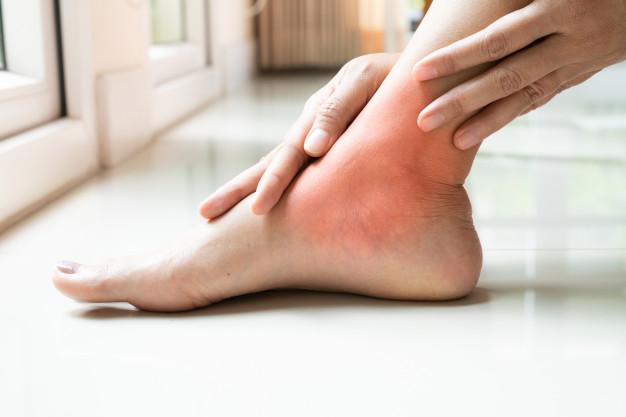
Image source/veinspecialistsVenous insufficiency may be a cause. When veins struggle to return blood efficiently to the heart, it can lead to poor circulation and skin discoloration. Chronic venous insufficiency may cause a brownish or reddish tint to the skin around the ankles.
23. Cracked Heels
Cracked heels, also known as heel fissures, can have various causes, and an underactive thyroid (hypothyroidism) is one potential factor that may contribute to this condition. Hypothyroidism is a condition where the thyroid gland does not produce enough thyroid hormones.
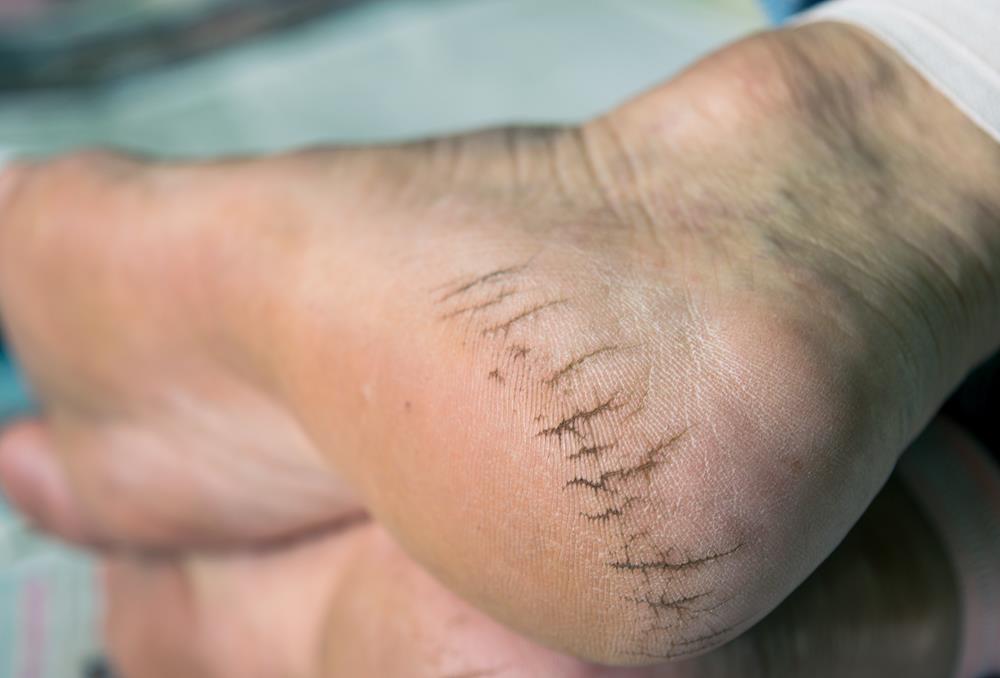
Image source/absolutefootandankleclinicIf you suspect an underactive thyroid may be contributing to your cracked heels, it's advisable to consult with a healthcare professional. They can perform tests to assess thyroid function and determine whether hypothyroidism is affecting your skin health.
24. Green Toenails
If you're noticing that your toenails are going green, it may be due to chloronychia - this is caused by the bacterium "Pseudomonas aeruginosa"
which presents itself when the foot is exposed to water or certain soaps and detergents. It can be treated very easily with medical soaking or keeping the nails dry.
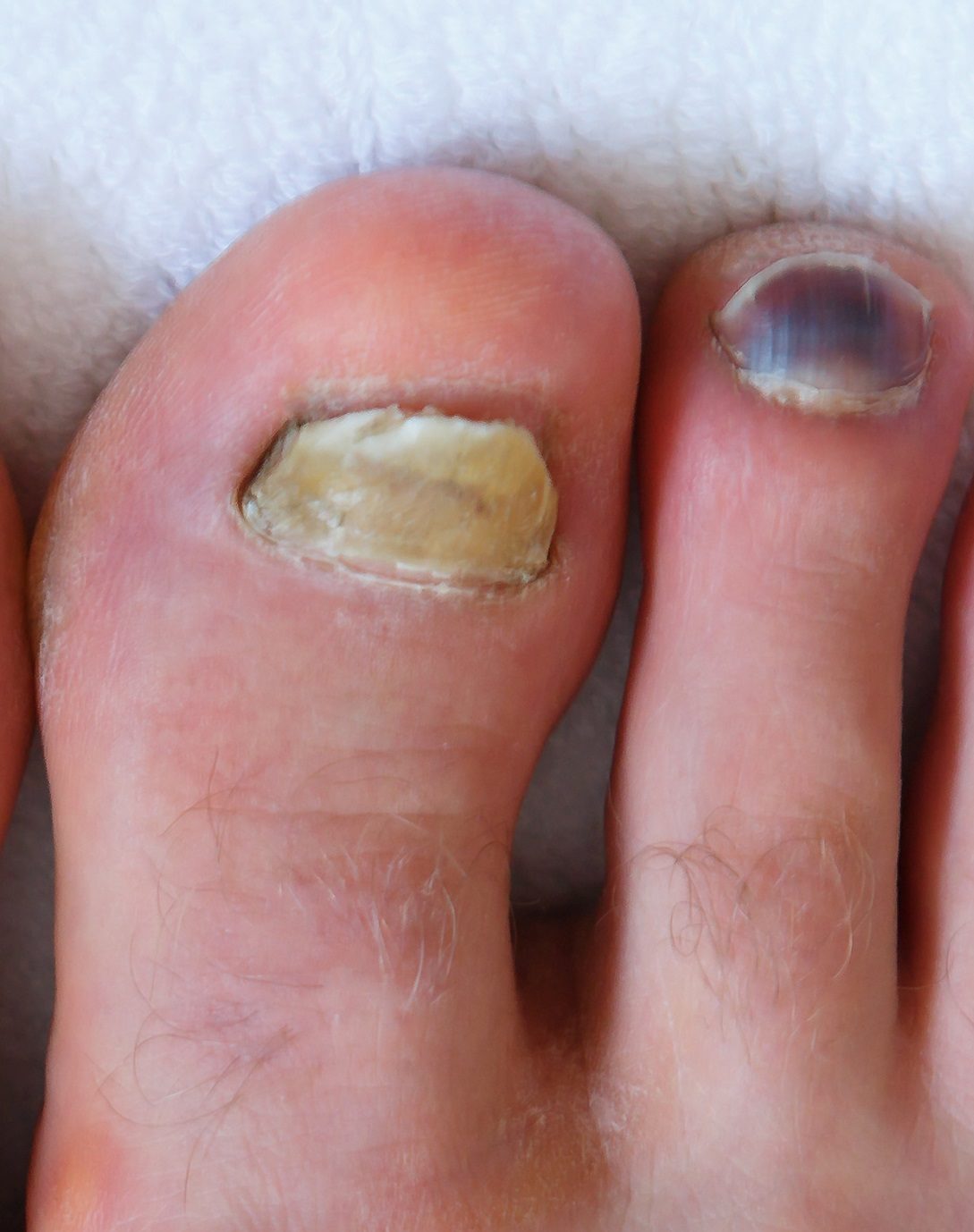
Image source/michiganfootdoctorExposure to certain chemicals or environmental factors, such as copper-containing compounds, can contribute to greenish discoloration. There are also certain medical conditions like yellow nail syndrome or certain metabolic disorders that may cause this nail color.
25. Swollen Ankles Can Be A Sign of High Blood Pressure
The most common cause of swollen ankles is fluid retention, often due to an imbalance in the body's fluid regulation. Conditions like heart failure, kidney disease or liver disease can contribute to fluid build up. Sufferers are requested to keep their feet elevated when they are sitting down.
:max_bytes(150000):strip_icc()/GettyImages-1277450943-a26b6a2e487d4ace982627bd9a815cac.jpg)
Image source/verywellhealthHigh blood pressure has the heart working over time. Fluid builds up in the lower legs and ankles causing them to become swollen. You should go to see your doctor and get it checked out if you're unsure of what's going on. It's always better to be safe than sorry!
26. Never Ignore Brown Streaks In Your Toenail
A black or brown toenail could be a sign of subungual melanoma which is a form of skin cancer. If you've not had any injuries to your feet, then get your feet checked out. If the streak increases in size or doesn't heal, make am appointment with a dermatologist.

Image source/healthlineDon't panic if you do have a brown streak on your toenail. Although it could be serious, there is every chance it isn't but you must get a diagnosis. A lack of essential nutrients, such as biotin or iron, can affect the health of the nails and may contribute to discoloration.
27. Burning In Your Feet
Another symptom of neuropathy, PAD, peripheral neuropathy is to have burning feet and this can be due to diabetes or other factors. Burning feet can also be due to nerve damage in the legs from athlete's foot, however, it's often caused by PAD, so go and get checked if you're noticing these symptoms.

Image source/podiatryhealthlineA comprehensive evaluation can identify the underlying cause, allowing for timely intervention and management to alleviate your symptoms and prevent further issues. Early diagnosis enables individuals to adopt medical interventions for optimal foot health.
28. Feet That Are Really Painful To Walk On
Discomfort in your feet when you walk can be caused from malnutrition, including a vitamin D deficiency, a problem with absorbing calcium or anorexia. Women over the age of 55 with these pains, may need a bone density exam so just go and check in with your doctor to see what they say!
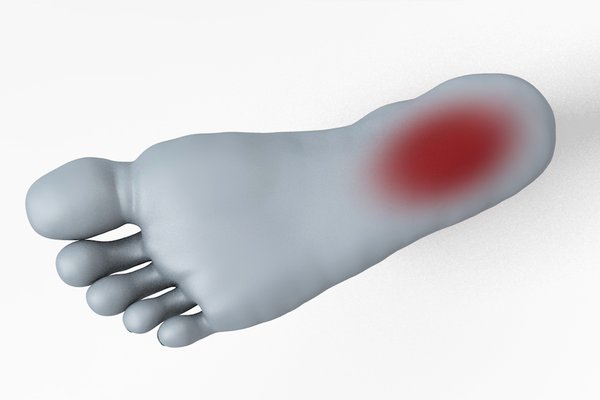
Image source/NHSTwo further reasons for those struggling to walk without experiencing pain are plantar fasciitis, inflammation of the tissue that connects the heel bone to the toes and the other is heel spurs, Bony outgrowths on the heel bone, known as heel spurs, can lead to pain, particularly when walking
29. Black Or Dark Toenails
Black or dark toenails are usually a sign of injury. If you've hurt your foot and bruised under the toe nail, it can cause the change in colour. However, bruises under the toenail can cause a fungal infection or a sore that can become infected. If you have diabetes ....
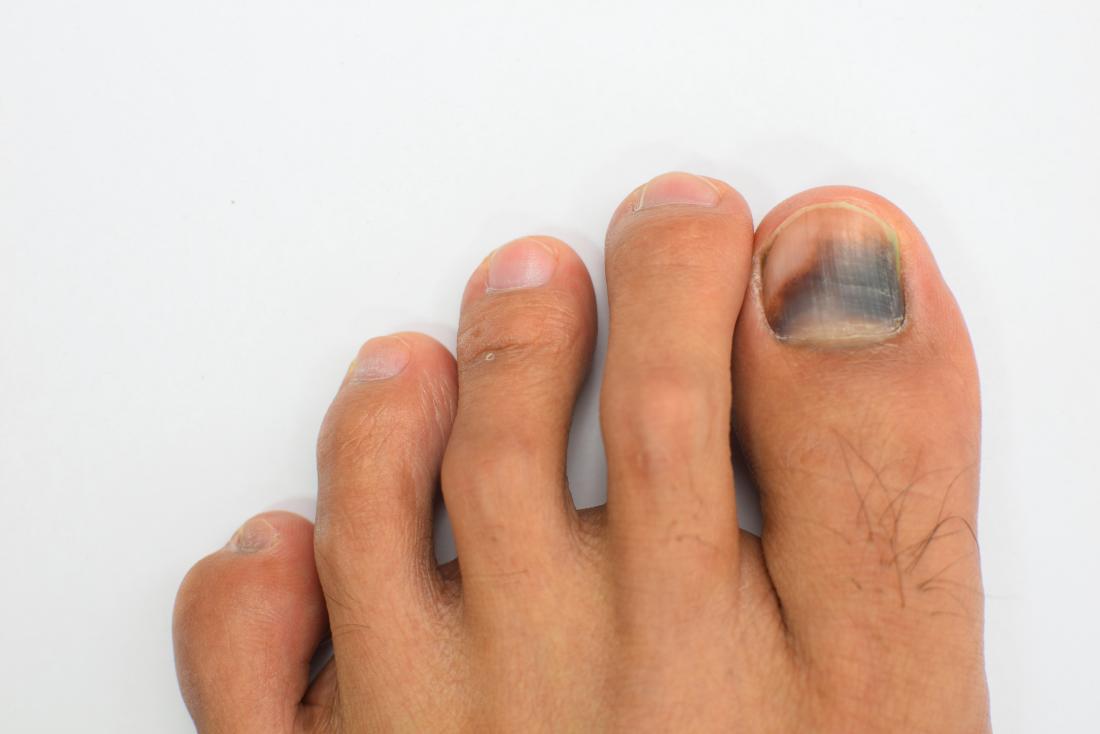
Image source/torbayfootcareYou should certainly seek medical help especially if you have diabetes and you notice black or very dark toenails. Your doctor can give you a thorough examination and specifically check your circulation and any possible nerve damage that might have occurred.
30. Heel Pain Can Be A Sign Of Plantar Fasciitis
If you get a sharp pain in the bottom of your heel when you get out of bed or stand up from your seat, it could be a strain from the ligament that supports your arch. Podiatrists will tell you to easy up on your workouts and to rethink your footwear which can make a difference.
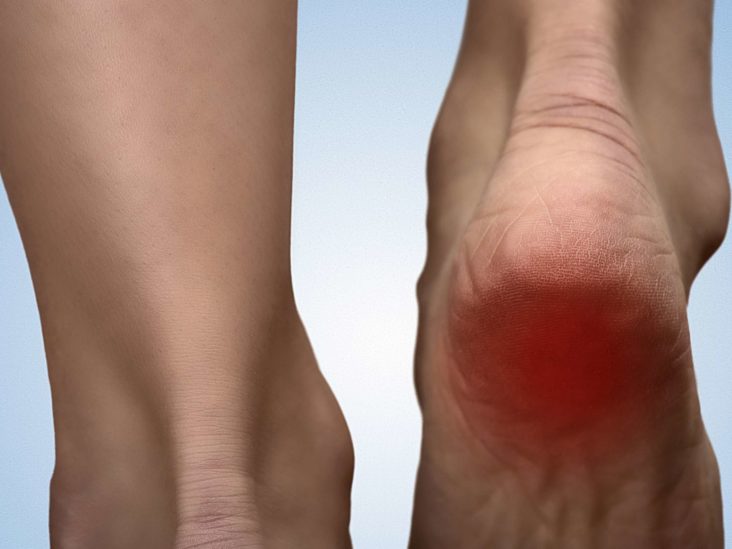
Image source/medicalnewstodayMake sure to stretch each day and this should ease the pain. A podiatrist may advise wearing a specific inset inside your footwear. This takes the pressure off your heel and allows you to walk without struggling with the discomfort this condition brings with it.
31. Pale Toenails
"They can also be caused by malfunctions in the liver or heart, or poor nutrition, so it is important to get this issue checked out," Podiatrist, Dina Gohil says. " If your nails are mostly white with a narrow pink band at the tip, it could be another condition ....
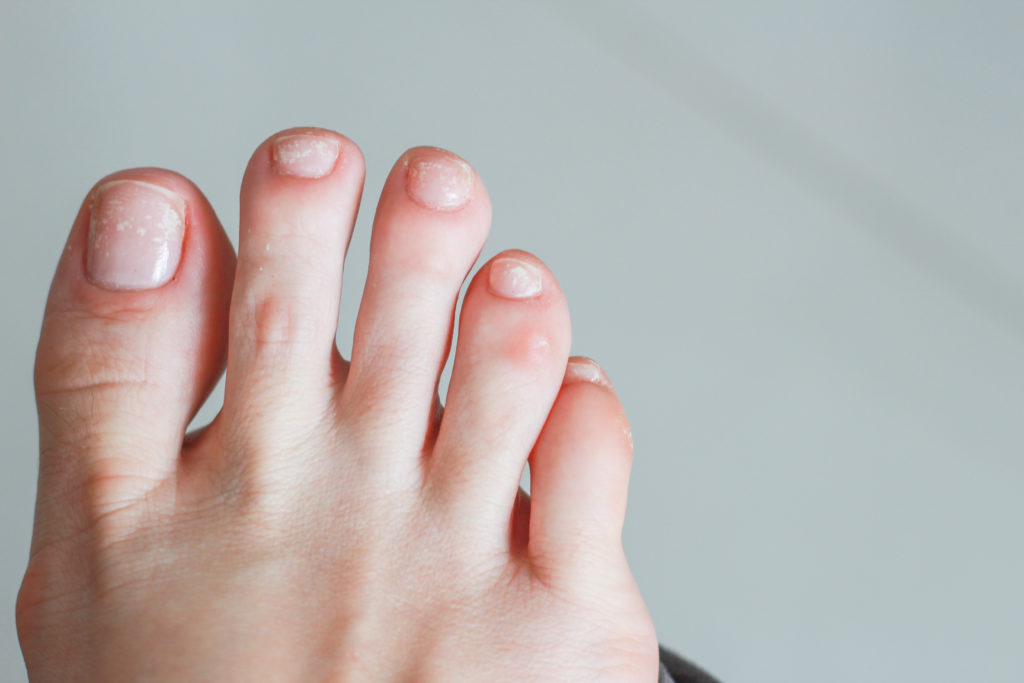
Image source/mrfootdrYou may notice pale toenails if you have a condition called "Terry's nails." Up to 80% of patients who suffer with severe liver disease have Terry's nails but they are also found in individuals with kidney failure and those with congestive heart failure.
32. White Spots In Your Nails
White spots on the nails, known as leukonychia, can result from various causes. Common reasons include minor trauma or injury to the nail matrix, fungal infections, zinc deficiency, or allergic reactions to nail products. In some cases, leukonychia is harmless and resolves on its own.
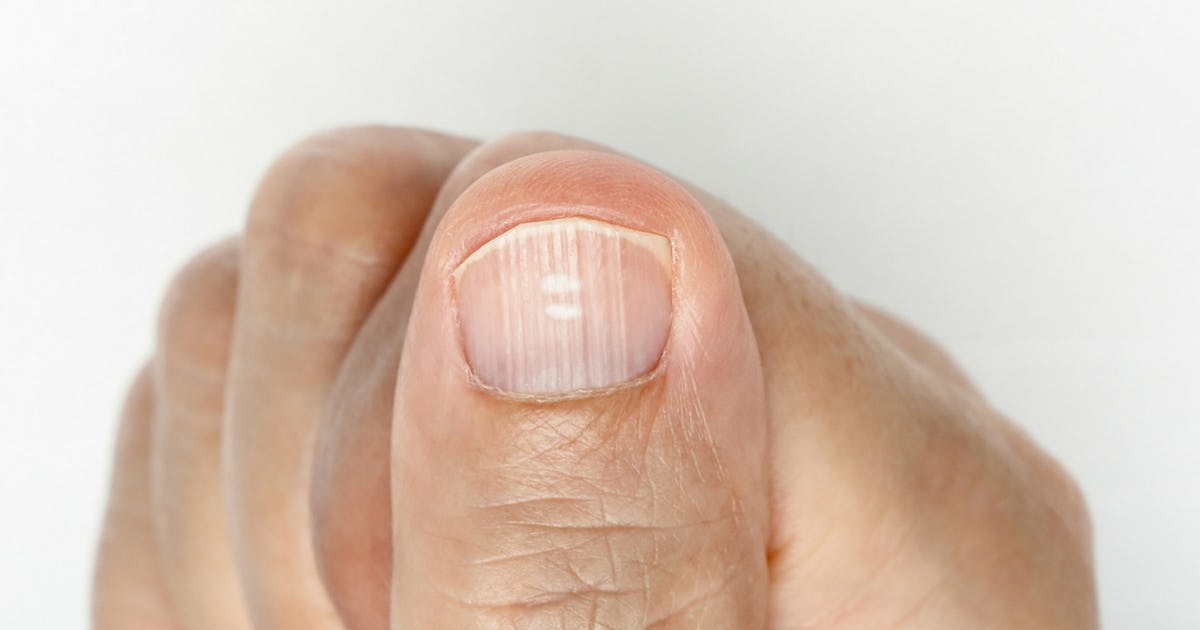
Image source/scarymom
However, persistent or widespread white spots may indicate an underlying issue and this is why consulting with a dermatologist or healthcare professional or dermatologist is advisable. You can then receive an accurate diagnosis and appropriate treatment.
33. If Your Toe Nails Have Gone Black
Toenails can turn black due to various reasons, often linked to trauma or injury. Stubbing the toe, dropping something heavy, or repetitive pressure on the toenail can cause bleeding under the nail, resulting in a black discoloration. Other reasons could be ....

Image source/torbayfootcareIf you notice your toenails have gone black, this could be due to an infection such as fungal growth or bacterial invasion. Additionally, systemic conditions like diabetes, poor circulation and even certain medications can impact toenail health. It's always best to get checked out.
34. Small Cysts That Grow Near Your Cuticle
If you've found a small cyst growing near or on the cuticles this may be an indication of arthritis. These cysts can be benign (not cancerous) but it's always best to address any health care professionals if you find any changes on your body - no matter how big or small.
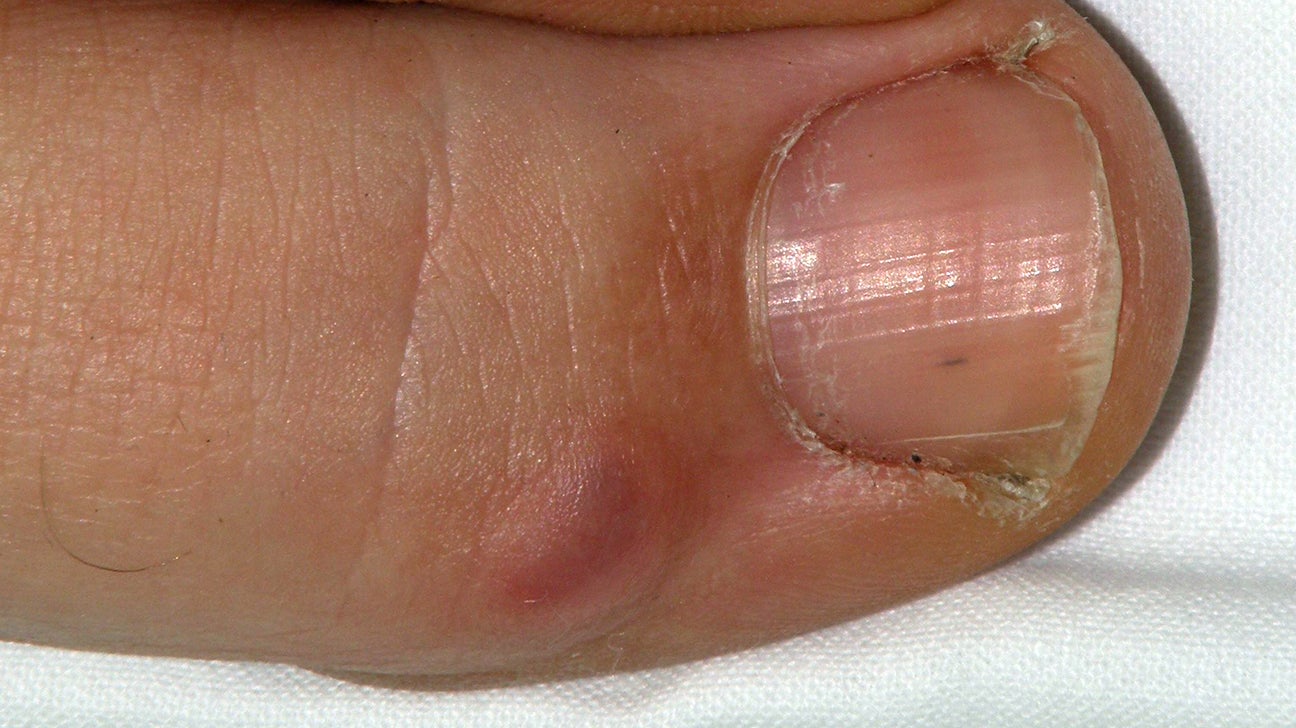
Image source/medicalnewstodayWhile they are more commonly found on the wrists or hands, small cysts can occasionally occur near the cuticle of a nail. The cysts often appear as small, round lumps and may be translucent or bluish in color. If the cysts bother you, then it's time to get a proper diagnosis.
35. Scaly Red Patches That Impact Your Fingers Or Toes
Scaly red patches affecting fingers or toes can stem from various causes including dermatitis or eczema, characterized by inflammation or allergies. Psoriasis, an autoimmune condition, may lead to the rapid turnover of skin cells, resulting in red, scaly patches on fingers and toes.
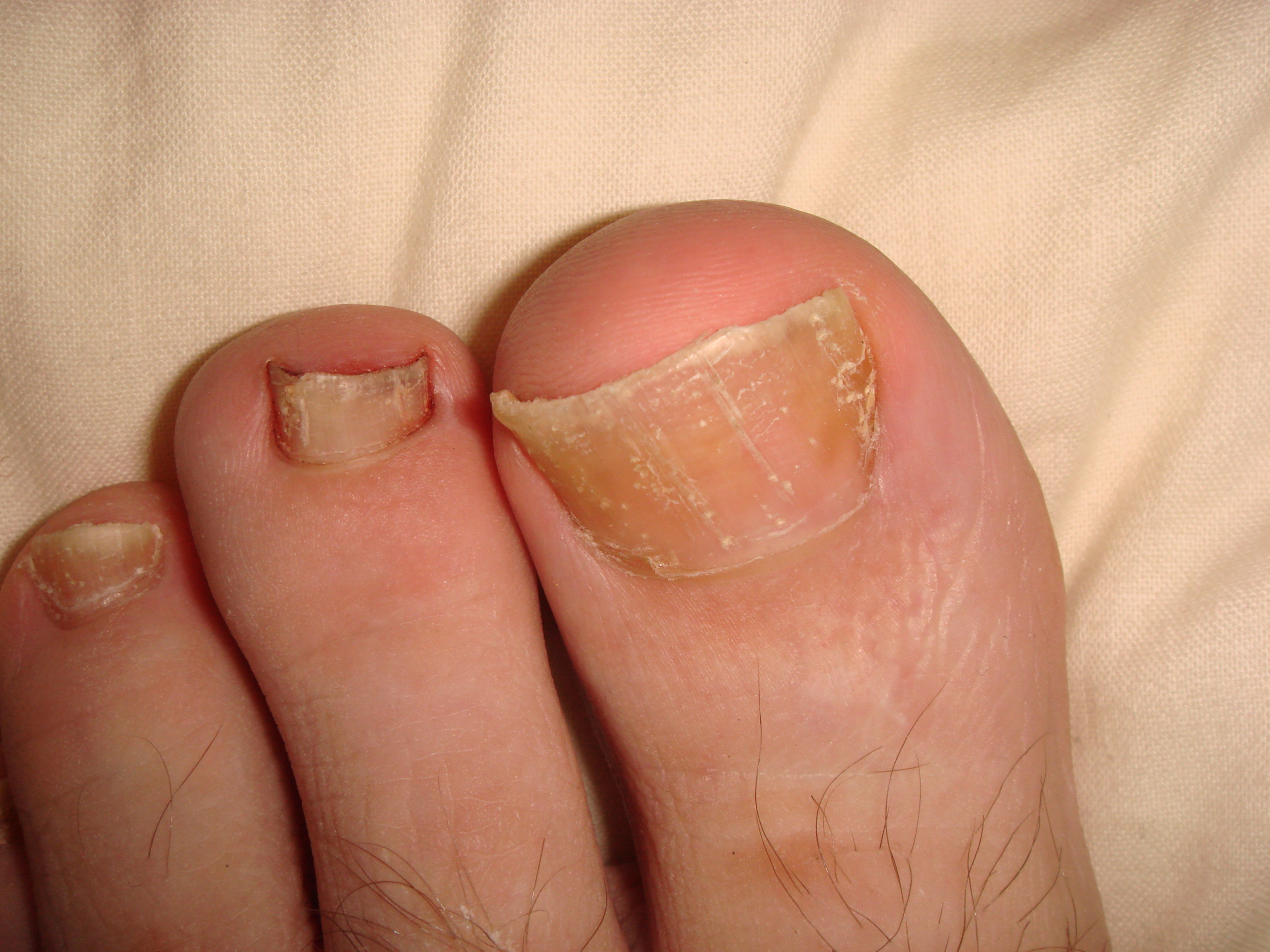
Image source/NHSFungal infections, athlete's foot in particular, commonly manifest as red, scaly areas between toes. Then there is contact dermatitis which arises from exposure to irritants and presents as red, itchy patches. Prescribed creams or lotions may be all that is required to eradicate the issue.
36. Smelly Feet
Everyone get smelly feet from time to time - it's normal when you think that your feet have over a quarter of a million sweat glands. However, when your feet constantly smell and others around you are even mentioning it to you, there could be another reason ....

Image source/refinery29A fungal infection like athlete's foot may contribute to a persistent and unpleasant odor. It's caused by a fungi called Trichophyton which thrives in warm, moist environments. This makes feet a perfect breeding ground and it can spread from one foot to another.
37. Cramping In Your Feet
Foot cramping can result from various factors including dehydration, electrolyte imbalances and mineral deficiencies such as potassium or magnesium. Overuse or fatigue, improper footwear, nerve compression and poor blood circulation may contribute to muscle cramps.

Image source/youtubeAdditionally, exercise-induced cramps, medication side effects and underlying medical conditions like diabetes or peripheral neuropathy can affect muscle function in the feet. Regular hydration, a balanced diet, appropriate footwear and stretching exercises can help prevent cramps.
38. Swollen Or Sore Feet
Swollen or sore feet can stem from various causes, commonly attributed to prolonged standing, walking, or improper footwear leading to overuse and muscle fatigue. Additionally, conditions like venous insufficiency, edema, or poor circulation can contribute to swelling.

Image source/medicalnewstodayInjuries such as sprains or fractures and inflammatory conditions like arthritis or tendonitis may result in soreness. Systemic factors like heart or kidney issues can also manifest as foot swelling. Lifestyle adjustments, proper footwear and elevation can help alleviate symptoms.
39. Crumbly Nails
Toenails that are discoloured and crumbly can often be a sign of fungal infection but if the infection is at the nail bed it could mean that your toe has experienced some trauma to the area. Treatment can be found at that pharmacy with an oral or topical anti-fungal.
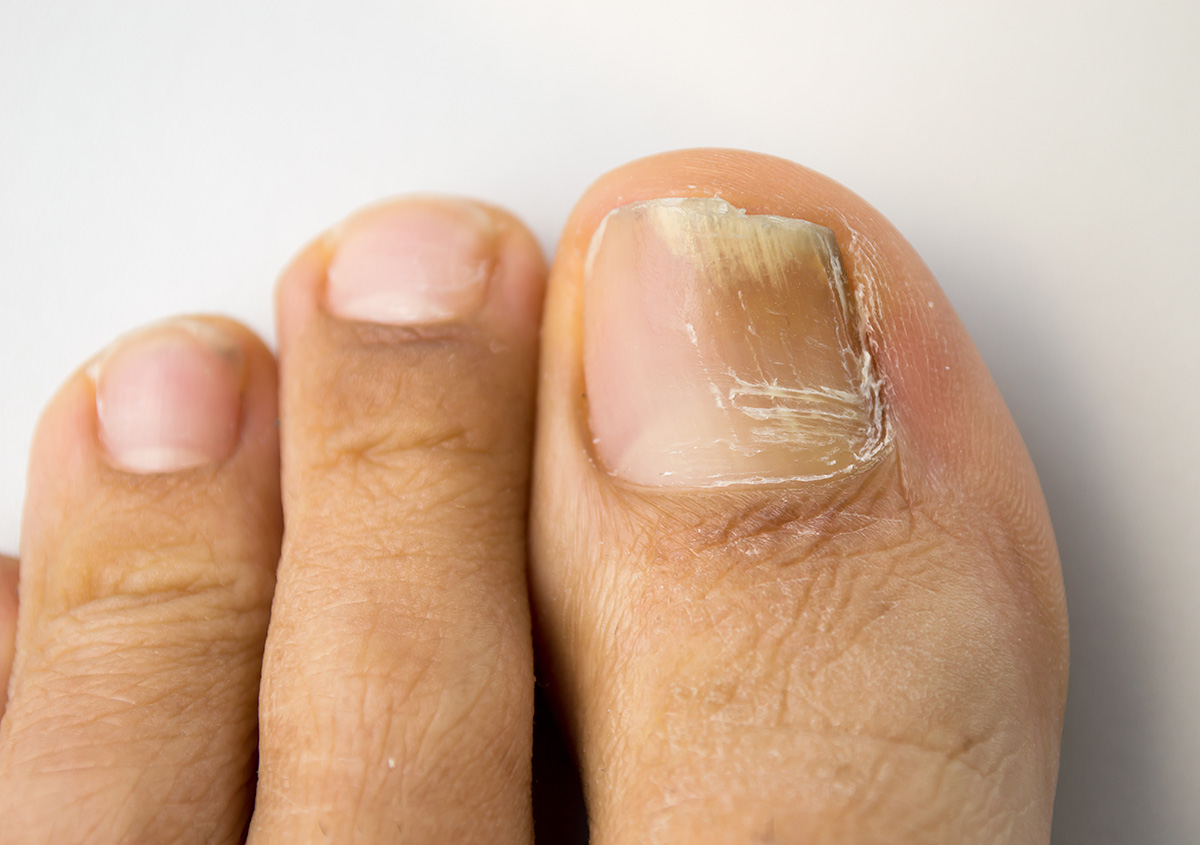
Image source/diamondskincarePoor nail hygiene, extended exposure to moisture and aging can also contribute towards crumbly nails. Treating crumbly toenails involves addressing the underlying cause which may require antifungal medications, proper nail care and various lifestyle adjustments.
40. Spoon Shaped Nails
Spoon-shaped toenails, known as koilonychia, can be linked to various factors. Iron deficiency anemia is a common cause, affecting the shape and structure of the nails. Other contributors include trauma, fungal infections or autoimmune conditions like lupus.
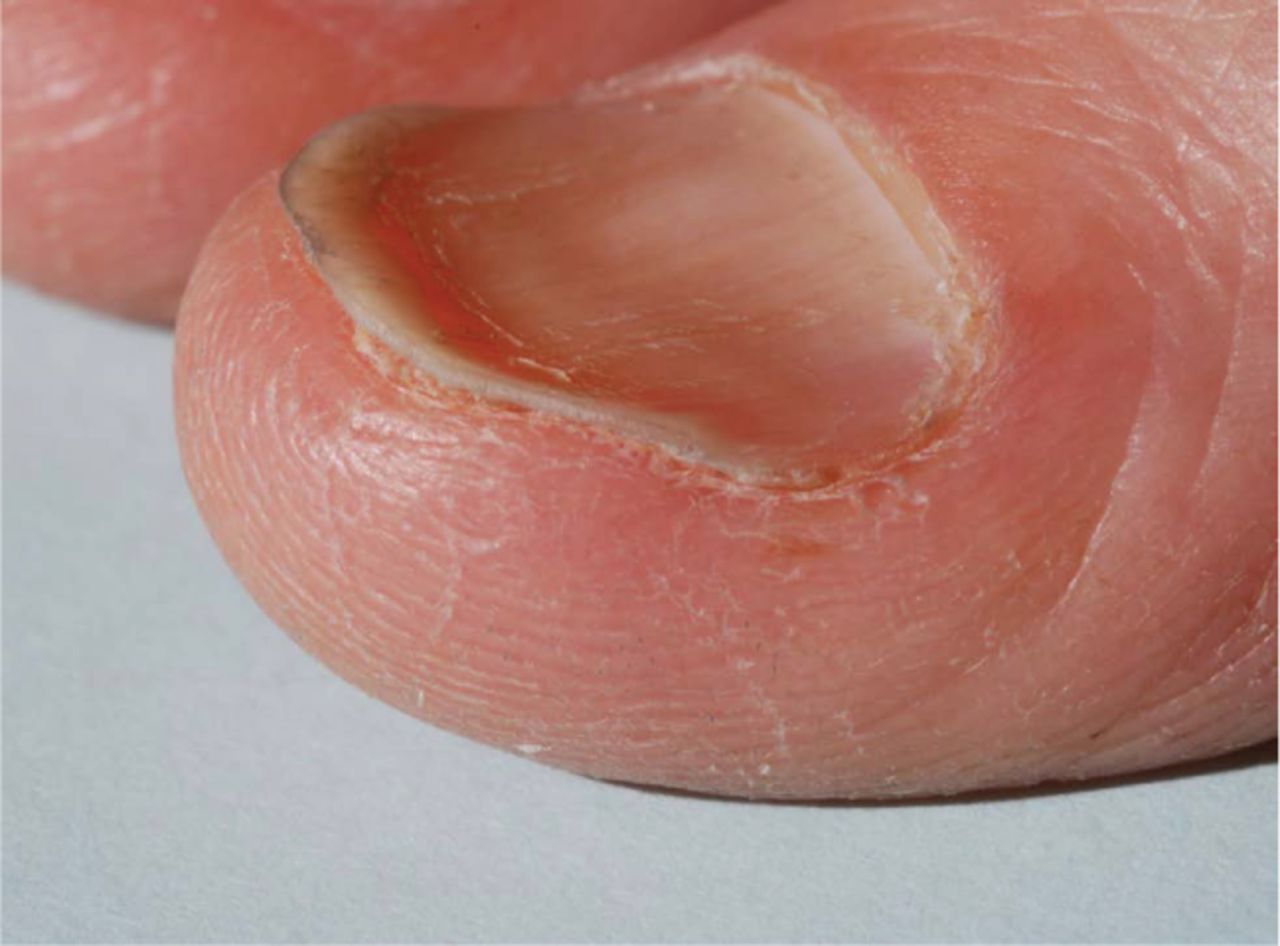
Image source/RCPjournalsIn some cases, it could even be a genetic trait. Monitoring iron levels, adopting a nutrient-rich diet and addressing, not ignoring, underlying health issues can help manage spoon shaped toenails. Your pharmacist may be able to advise the best course of action if necessary.
41. Here's What Your Feet Say About Your Personality
Everyone has different shaped feet but there are numerous types of shaped feet and they all have special meanings behind them! It's important to approach these interpretations with cultural sensitivity and acknowledge that scientific evidence supporting such correlations still has some way to go.

Image source/healthlineUltimately, foot shapes are influenced by genetics, environment and individual variations. Some experts believe your personality can be described by the shape of your feet and the size of your toes. We tried it and it is spookily on the right lines. Try it on yourself and see if you agree!
42. The Egyptian Toes
Egyptian feet, characterized by toes of nearly equal length, are often associated with balance and harmony in personality traits. It is characterised by the big toe being the largest and the rest of the toes tapering off at an almost perfect 45 degree angle.
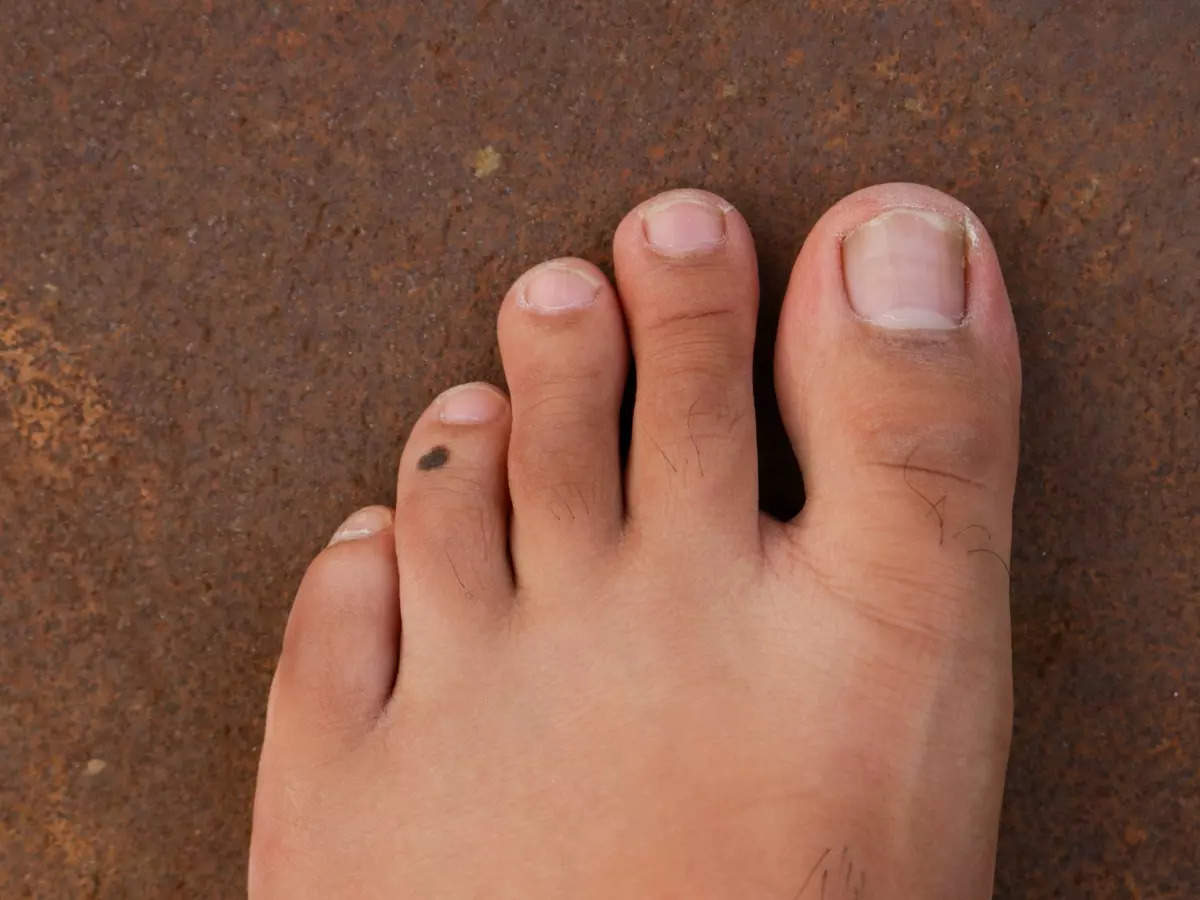
Image source/timesofindiaAccording to some interpretations in prodomorphology, individuals with Egyptian toes are thought to exhibit a well-proportioned and harmonious disposition. People with this foot shape are believed to be well-rounded, diplomatic, and adaptable, possessing a balanced approach to life.
43. The Roman Toes
If your first three toes are the same height and the last two are in descending order then you have what is known as the Roman Foot! People with this foot shape are usually outgoing and positive as well as being passionate especially when it comes to exploring.
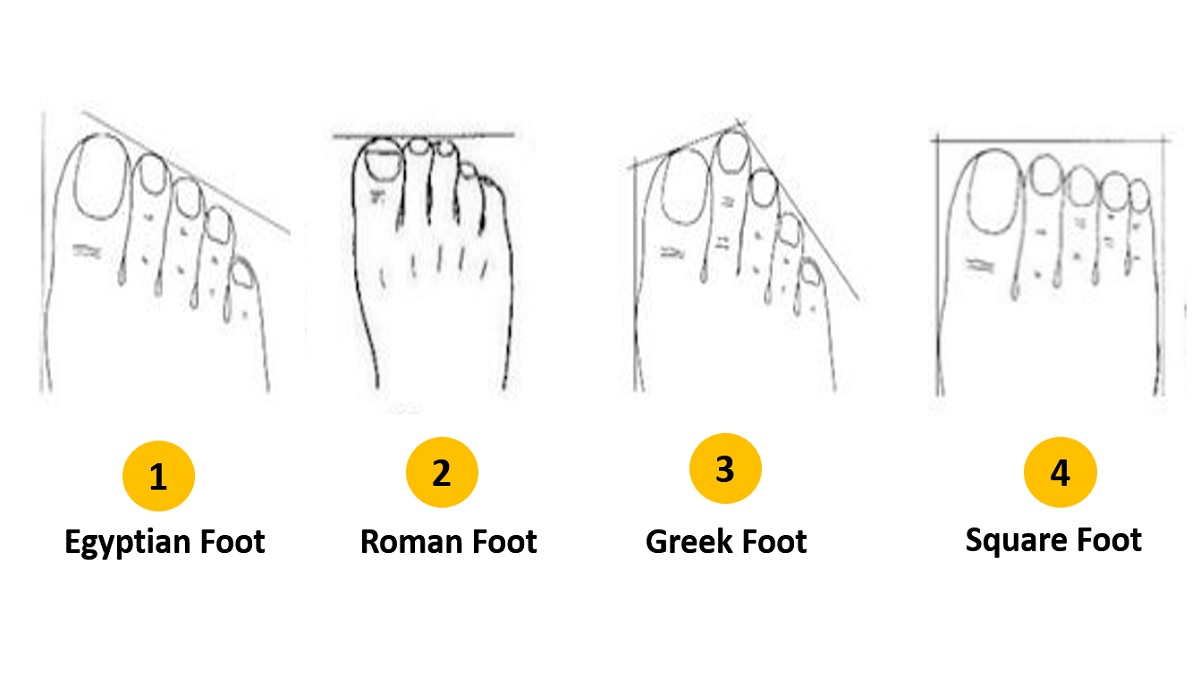
Image source/jarganjoshThose with Roman toes are said to be practical and grounded in their personality trait. Individuals with Roman toes are thought to be pragmatic, down to earth and well suited to tasks that require stability and practicality. You're on to a winner if this is you!
44. Peasant Toes
Peasant Toes, sometimes known by the description of ''Square Feet'' are when the toes are all practically the same length which gives a "square-like" appearance. The people with this shape foot tend to be rational and reliable. They're great people to have around you!
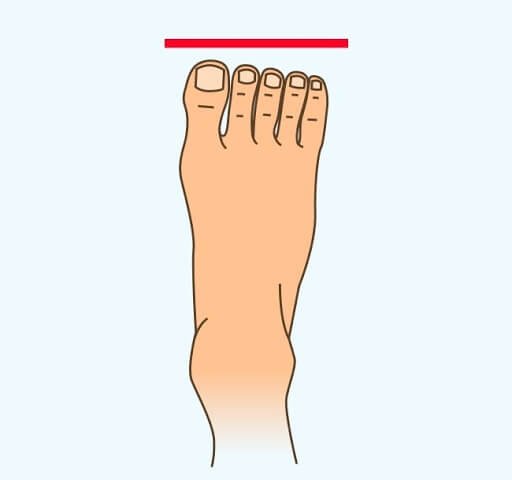
Image source/hopytapyThe idea that personality traits can be accurately determined by looking at someone's toes is not scientifically supported but, much like reading palms, tarot cards and the such like, the outcome can appear to be so much more than simply a coincidence!
45. Flame Toes
The Flame, or Greek foot, is when the second toe exceeds the length of the big toe, and all the other toes. Those with flame toes tend to be natural born leaders who rarely get stressed out and glide their way easily through difficult and sensitive situations.

Image source/pinterestThose with flame toes are believed to possess great qualities such as creativity, specifically in the art world, enthusiasm on another level and a love for adventure. If you are fortunate enough to fall into this category, we so want to be your buddy!
46. Inability To Separate The Little Toe
Speaking specifically about whether or not you can separate your little toe without the help from your hands/tools - this means that you are a loyal companion who loves having a routine to follow, even to the extreme of struggling without one in place.

Image source/capoeiraOne common explanation, if you can't separate your little toe, is that your toes may be naturally positioned closely together due to the structure of your foot or the alignment of the joints. It's absolutely nothing to worry about - we're all different!
47. Ability To Separate The Little Toe
As you might have already guessed, those that have the ability to separate their smallest toes have completely opposite personalities to those who can't! They're more free spirited and laid back with more of a care free attitude towards life in general.
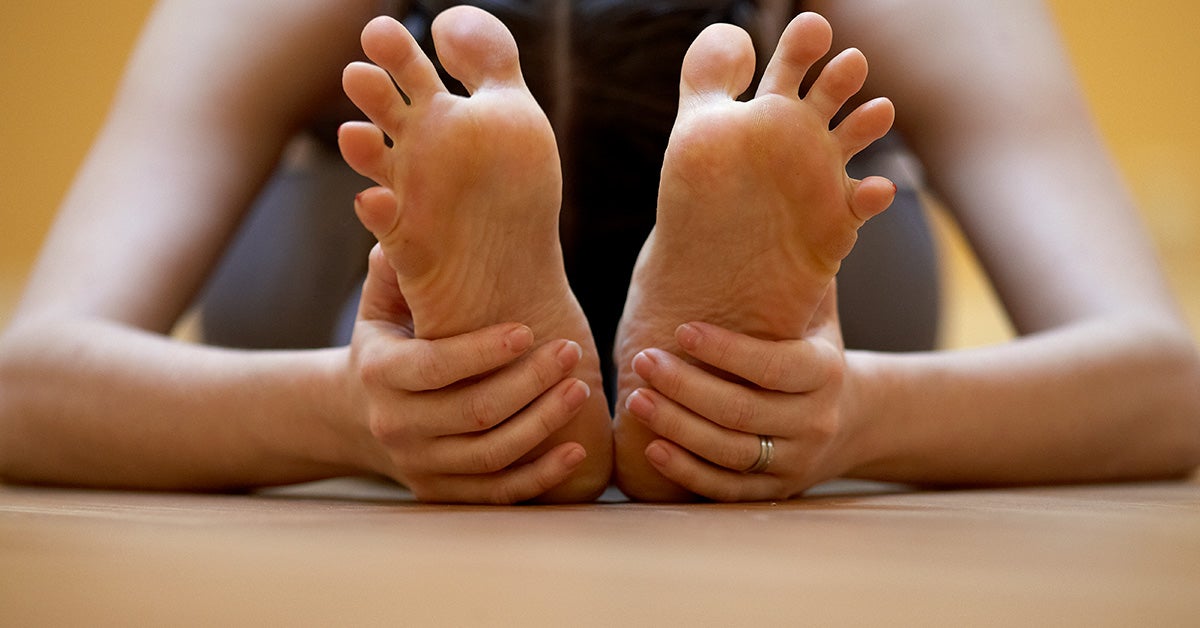
Image source/healthlineThose who are able to separate their little toe hate are said to hate routine and be very "spur of the moment" people. They are the type of person who might book a last minute flight, pack a holdall and be off, without a care in the world! I wish that was me!
48. An Extra Small Toe
Similarly to the Egyptian Toe, the only difference here is that the pinky (little) toe is smaller than usual. People with this shaped foot tend to be quite secretive when it comes to their personal lives and they keep their cards close to their chest, taking a while to really open up.
Image source/redditSo we said they can be secretive but, on the plus side, they are good at keeping a secret and are proven to be good friends. As they don't vent any problems they might have, they have a habit of working out the answer in their head - not a bad trait to have.
49. Wide Set Toes
Known as the ''travellers foot'', these feet have evident gaps between the toes or can be easily stretched far apart. People with wide set toes are more often than not, obsessed with travelling and yearn to throw themselves into an unforgettable adventure.
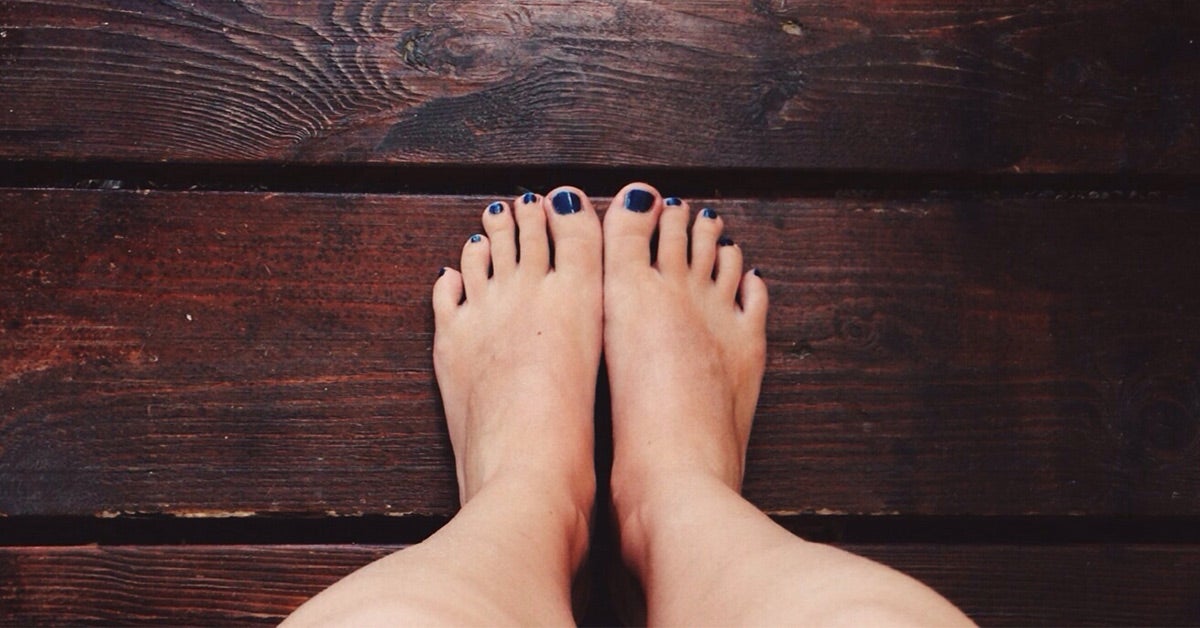
Image source/healthlineMoving on to a sensible, factual front - individuals with wide set toes usually have great balance! They are also known to experience fewer issues related to toe crowding, reducing the likelihood of conditions like painful bunions or overlapping toes.
50. Stretched Toes
Not to be confused with the Egyptian Toe, stretched toes are when the big toe is clearly distanced from all the other toes. Very independent and love doing things for themselves, people with this foot shape also hate being indoors and they don't loke being told what to do!
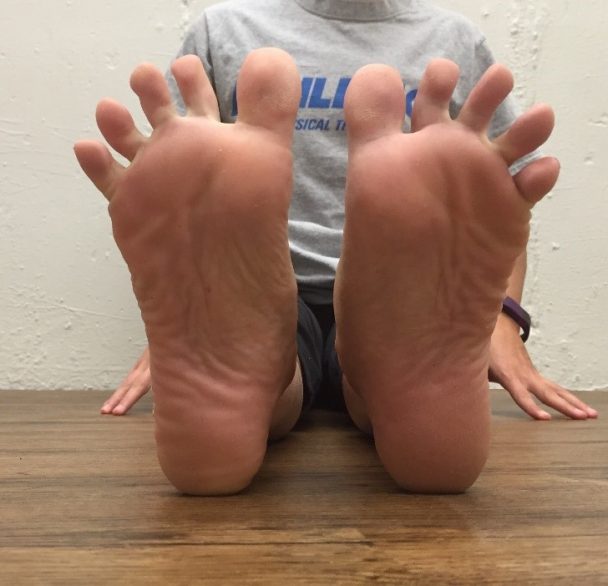
Image source/athleticopysicalIn some cases, believe it or not, individuals may intentionally try to stretch their toes through practices like toe exercises or by wearing specific footwear designed to encourage toe splaying. They do this to gain better balance and avoid toe overcrowding.
 Image source/womenshealthConsult with a doctor if you notice any abnormalities. Persistent concave toenails may warrant a thorough medical examination to identify the root cause and implement appropriate interventions. Any concerns related to nail abnormalities should be addressed.Original content sourced from Femanin.com
Image source/womenshealthConsult with a doctor if you notice any abnormalities. Persistent concave toenails may warrant a thorough medical examination to identify the root cause and implement appropriate interventions. Any concerns related to nail abnormalities should be addressed.Original content sourced from Femanin.com Image source/redditThe reduced blood flow can lead to various symptoms, including hair loss on the feet or toes. Other symptoms of PAD may include leg pain or cramping during physical activity, numbness or weakness and slow-healing sores or wounds. It's actually not uncommon in middle aged Americans.
Image source/redditThe reduced blood flow can lead to various symptoms, including hair loss on the feet or toes. Other symptoms of PAD may include leg pain or cramping during physical activity, numbness or weakness and slow-healing sores or wounds. It's actually not uncommon in middle aged Americans. Image source/medicalnewstodayInsufficient levels of minerals like potassium, magnesium or calcium may also result in foot cramping. On a more serious note, underlying medical conditions such as diabetes, hypothyroidism or neurological disorders can contribute to uncomfortable foot cramping.
Image source/medicalnewstodayInsufficient levels of minerals like potassium, magnesium or calcium may also result in foot cramping. On a more serious note, underlying medical conditions such as diabetes, hypothyroidism or neurological disorders can contribute to uncomfortable foot cramping. Image source/drugs.comChronic or deep-seated infections in the feet can also impede the healing process as can certain autoimmune conditions. If someone has persistent sores on their feet, it's crucial to seek medical attention promptly. A healthcare professional, often a podiatrist, can advise.
Image source/drugs.comChronic or deep-seated infections in the feet can also impede the healing process as can certain autoimmune conditions. If someone has persistent sores on their feet, it's crucial to seek medical attention promptly. A healthcare professional, often a podiatrist, can advise. Image source/medicalnewstodaySurprisingly, chronic stress can lead to vasoconstriction, reducing blood flow to the feet and causing coldness. Raynaud's Disease, in rarer cases, causes blood vessels to narrow in response to cold or stress, affecting blood flow to the extremities, another condition for constant cold feet.
Image source/medicalnewstodaySurprisingly, chronic stress can lead to vasoconstriction, reducing blood flow to the feet and causing coldness. Raynaud's Disease, in rarer cases, causes blood vessels to narrow in response to cold or stress, affecting blood flow to the extremities, another condition for constant cold feet. Image source/preferredfootandankleclinicCertain skin conditions, like eczema, can extend to the nails and cause changes. Your age can also be the reason as normal aging processes can lead to changes in the nails, including thickening. Finally, trauma damage to the toenail can result in thickening and discoloration.
Image source/preferredfootandankleclinicCertain skin conditions, like eczema, can extend to the nails and cause changes. Your age can also be the reason as normal aging processes can lead to changes in the nails, including thickening. Finally, trauma damage to the toenail can result in thickening and discoloration. Image source/certifiedfootandankleclinicLack of essential nutrients such as vitamin B12 or folate can be contributory factors towards peripheral neuropathy. Also, excessive alcohol consumption can lead to a variety of symptoms including nerve damage and numbness in both feet. Seek help and don't suffer.
Image source/certifiedfootandankleclinicLack of essential nutrients such as vitamin B12 or folate can be contributory factors towards peripheral neuropathy. Also, excessive alcohol consumption can lead to a variety of symptoms including nerve damage and numbness in both feet. Seek help and don't suffer. Image source/creakyjointsAccording to John Hopkins Medicine, signs of rheumatoid arthritis typically start in the small joins or the hands and feet. If you have persistent achiness or swelling, talk to your doctor about seeing a rheumatologist. It's always better to get a consultation sorted out.
Image source/creakyjointsAccording to John Hopkins Medicine, signs of rheumatoid arthritis typically start in the small joins or the hands and feet. If you have persistent achiness or swelling, talk to your doctor about seeing a rheumatologist. It's always better to get a consultation sorted out.:max_bytes(150000):strip_icc()/iStock-670950774-58ff78db5f9b581d594b02f5-969c69c3b29f41d5a163384cf41e86bf.jpg) Image source/verywellhealthWhen thyroid hormone levels are low, it can affect the skin's ability to stay hydrated and maintain its natural moisture. Dry skin is a common symptom of hypothyroidism, and this dryness can extend to the feet. This hormones play a crucial role in regulating skin health.
Image source/verywellhealthWhen thyroid hormone levels are low, it can affect the skin's ability to stay hydrated and maintain its natural moisture. Dry skin is a common symptom of hypothyroidism, and this dryness can extend to the feet. This hormones play a crucial role in regulating skin health. Image source/rapidcareemergencyroomThere is a condition called paronychia, an infection of the skin around the nail. It can be caused by bacteria or fungi and may result from ingrown toenails or other types of trauma and can be very painful. As with finger nails, any change in nail appearance should not be ignored.
Image source/rapidcareemergencyroomThere is a condition called paronychia, an infection of the skin around the nail. It can be caused by bacteria or fungi and may result from ingrown toenails or other types of trauma and can be very painful. As with finger nails, any change in nail appearance should not be ignored. Image source/clevelandclinicSmall red lines under the toe nail could be broken blood vessels known as splinter haemorrhages but it can also be a sign of endocarditis which is an infection of the heart's inner lining. So if you notice little splinters and you haven't experienced any trauma to the nail, then keep an eye on it.
Image source/clevelandclinicSmall red lines under the toe nail could be broken blood vessels known as splinter haemorrhages but it can also be a sign of endocarditis which is an infection of the heart's inner lining. So if you notice little splinters and you haven't experienced any trauma to the nail, then keep an eye on it. Image source/wikipediaIt's important to note that nail clubbing is not a disease in itself but a clinical sign that suggests an underlying medical condition. If you observe changes in the shape and appearance of your nails, particularly if you notice clubbing, it's crucial to seek medical attention.
Image source/wikipediaIt's important to note that nail clubbing is not a disease in itself but a clinical sign that suggests an underlying medical condition. If you observe changes in the shape and appearance of your nails, particularly if you notice clubbing, it's crucial to seek medical attention. Image source/newsmedicalCertain connective tissue disorders, such as systemic lupus erythematosus (SLE), can be associated with nail changes, including pitting. You probably weren't aware that alopecia areata, a condition that primarily affects hair follicles, can also cause changes in the nails, including pitting.
Image source/newsmedicalCertain connective tissue disorders, such as systemic lupus erythematosus (SLE), can be associated with nail changes, including pitting. You probably weren't aware that alopecia areata, a condition that primarily affects hair follicles, can also cause changes in the nails, including pitting. Image source/peninsulaorthopedicOver time, the abnormal positioning of the big toe joint can lead to quite severe pain, inflammation and sometimes difficulty in finding comfortable footwear. Surgery is the only answer to getting rid of bunions for good and it's a 4-6 week recovery process.
Image source/peninsulaorthopedicOver time, the abnormal positioning of the big toe joint can lead to quite severe pain, inflammation and sometimes difficulty in finding comfortable footwear. Surgery is the only answer to getting rid of bunions for good and it's a 4-6 week recovery process. Image source/medicalnewstodayRegular nail care, wearing comfortable, breathable shoes and maintaining proper foot hygiene can all contribute to overall nail health. If concerns persist, seeking advice from a healthcare professional ensures an accurate diagnosis and appropriate treatment.
Image source/medicalnewstodayRegular nail care, wearing comfortable, breathable shoes and maintaining proper foot hygiene can all contribute to overall nail health. If concerns persist, seeking advice from a healthcare professional ensures an accurate diagnosis and appropriate treatment. Image source/danpreecePrompt medical evaluation is crucial for an accurate diagnosis, as underlying conditions require tailored treatments, including physical therapy, orthotic devices and surgery. Early intervention improves the prognosis and enhances the quality of life for individuals experiencing foot drop.
Image source/danpreecePrompt medical evaluation is crucial for an accurate diagnosis, as underlying conditions require tailored treatments, including physical therapy, orthotic devices and surgery. Early intervention improves the prognosis and enhances the quality of life for individuals experiencing foot drop. Image source/medicalnewstodayWhile cold exposure is a well-known trigger, it's important to note that stress, both physical and emotional, can also induce Raynaud's episodes. The physiological response involves vasospasm, a temporary narrowing of blood vessels that limits blood supply to affected areas.
Image source/medicalnewstodayWhile cold exposure is a well-known trigger, it's important to note that stress, both physical and emotional, can also induce Raynaud's episodes. The physiological response involves vasospasm, a temporary narrowing of blood vessels that limits blood supply to affected areas. Image source/mersinsistemIngrown toenails can also ruin any chance of wearing nice open toed shoes in the summer which can be frustrating for the fashion conscious. Some sufferers assume the issue will ort itself when the nail grows out but this is certainly not the case at all - it can get worse.
Image source/mersinsistemIngrown toenails can also ruin any chance of wearing nice open toed shoes in the summer which can be frustrating for the fashion conscious. Some sufferers assume the issue will ort itself when the nail grows out but this is certainly not the case at all - it can get worse.:max_bytes(150000):strip_icc()/Tingling-In-Feet-GettyImages-1253661276-2000-a82926b8f1fa4f6c9ad6154549343121.jpg) Image source/healthA more serious and rarer condition of numbness and tingling is Multiple Sclerosis. One of the first symptoms of MS is often a numbness or tingling sensation, sometimes in the feet. With MS, one foot may have a different sensation to the other, making it difficult to stay mobile.
Image source/healthA more serious and rarer condition of numbness and tingling is Multiple Sclerosis. One of the first symptoms of MS is often a numbness or tingling sensation, sometimes in the feet. With MS, one foot may have a different sensation to the other, making it difficult to stay mobile. Image source/davisfinneyfoundationRestless legs syndrome tends to worsen during periods of inactivity, such as when sitting or lying down and is commonly experienced at night, leading to disrupted sleep. Low levels of iron in the brain may be associated with RLS. Neurotransmitters regulates muscle movement, relying on iron.
Image source/davisfinneyfoundationRestless legs syndrome tends to worsen during periods of inactivity, such as when sitting or lying down and is commonly experienced at night, leading to disrupted sleep. Low levels of iron in the brain may be associated with RLS. Neurotransmitters regulates muscle movement, relying on iron. Image source/heartveinnycDuring pregnancy, hormonal changes and increased pressure on the veins due to the growing uterus can lead to the development of varicose veins, including those in the ankle area. Also, older age can bring on the unsightly veins as they lose efficiency in returning blood to the heart.
Image source/heartveinnycDuring pregnancy, hormonal changes and increased pressure on the veins due to the growing uterus can lead to the development of varicose veins, including those in the ankle area. Also, older age can bring on the unsightly veins as they lose efficiency in returning blood to the heart. Image source/veinspecialistsVenous insufficiency may be a cause. When veins struggle to return blood efficiently to the heart, it can lead to poor circulation and skin discoloration. Chronic venous insufficiency may cause a brownish or reddish tint to the skin around the ankles.
Image source/veinspecialistsVenous insufficiency may be a cause. When veins struggle to return blood efficiently to the heart, it can lead to poor circulation and skin discoloration. Chronic venous insufficiency may cause a brownish or reddish tint to the skin around the ankles. Image source/absolutefootandankleclinicIf you suspect an underactive thyroid may be contributing to your cracked heels, it's advisable to consult with a healthcare professional. They can perform tests to assess thyroid function and determine whether hypothyroidism is affecting your skin health.
Image source/absolutefootandankleclinicIf you suspect an underactive thyroid may be contributing to your cracked heels, it's advisable to consult with a healthcare professional. They can perform tests to assess thyroid function and determine whether hypothyroidism is affecting your skin health. Image source/michiganfootdoctorExposure to certain chemicals or environmental factors, such as copper-containing compounds, can contribute to greenish discoloration. There are also certain medical conditions like yellow nail syndrome or certain metabolic disorders that may cause this nail color.
Image source/michiganfootdoctorExposure to certain chemicals or environmental factors, such as copper-containing compounds, can contribute to greenish discoloration. There are also certain medical conditions like yellow nail syndrome or certain metabolic disorders that may cause this nail color.:max_bytes(150000):strip_icc()/GettyImages-1277450943-a26b6a2e487d4ace982627bd9a815cac.jpg) Image source/verywellhealthHigh blood pressure has the heart working over time. Fluid builds up in the lower legs and ankles causing them to become swollen. You should go to see your doctor and get it checked out if you're unsure of what's going on. It's always better to be safe than sorry!
Image source/verywellhealthHigh blood pressure has the heart working over time. Fluid builds up in the lower legs and ankles causing them to become swollen. You should go to see your doctor and get it checked out if you're unsure of what's going on. It's always better to be safe than sorry! Image source/healthlineDon't panic if you do have a brown streak on your toenail. Although it could be serious, there is every chance it isn't but you must get a diagnosis. A lack of essential nutrients, such as biotin or iron, can affect the health of the nails and may contribute to discoloration.
Image source/healthlineDon't panic if you do have a brown streak on your toenail. Although it could be serious, there is every chance it isn't but you must get a diagnosis. A lack of essential nutrients, such as biotin or iron, can affect the health of the nails and may contribute to discoloration. Image source/podiatryhealthlineA comprehensive evaluation can identify the underlying cause, allowing for timely intervention and management to alleviate your symptoms and prevent further issues. Early diagnosis enables individuals to adopt medical interventions for optimal foot health.
Image source/podiatryhealthlineA comprehensive evaluation can identify the underlying cause, allowing for timely intervention and management to alleviate your symptoms and prevent further issues. Early diagnosis enables individuals to adopt medical interventions for optimal foot health. Image source/NHSTwo further reasons for those struggling to walk without experiencing pain are plantar fasciitis, inflammation of the tissue that connects the heel bone to the toes and the other is heel spurs, Bony outgrowths on the heel bone, known as heel spurs, can lead to pain, particularly when walking
Image source/NHSTwo further reasons for those struggling to walk without experiencing pain are plantar fasciitis, inflammation of the tissue that connects the heel bone to the toes and the other is heel spurs, Bony outgrowths on the heel bone, known as heel spurs, can lead to pain, particularly when walking Image source/torbayfootcareYou should certainly seek medical help especially if you have diabetes and you notice black or very dark toenails. Your doctor can give you a thorough examination and specifically check your circulation and any possible nerve damage that might have occurred.
Image source/torbayfootcareYou should certainly seek medical help especially if you have diabetes and you notice black or very dark toenails. Your doctor can give you a thorough examination and specifically check your circulation and any possible nerve damage that might have occurred. Image source/medicalnewstodayMake sure to stretch each day and this should ease the pain. A podiatrist may advise wearing a specific inset inside your footwear. This takes the pressure off your heel and allows you to walk without struggling with the discomfort this condition brings with it.
Image source/medicalnewstodayMake sure to stretch each day and this should ease the pain. A podiatrist may advise wearing a specific inset inside your footwear. This takes the pressure off your heel and allows you to walk without struggling with the discomfort this condition brings with it. Image source/mrfootdrYou may notice pale toenails if you have a condition called "Terry's nails." Up to 80% of patients who suffer with severe liver disease have Terry's nails but they are also found in individuals with kidney failure and those with congestive heart failure.
Image source/mrfootdrYou may notice pale toenails if you have a condition called "Terry's nails." Up to 80% of patients who suffer with severe liver disease have Terry's nails but they are also found in individuals with kidney failure and those with congestive heart failure. Image source/scarymom
Image source/scarymom Image source/torbayfootcareIf you notice your toenails have gone black, this could be due to an infection such as fungal growth or bacterial invasion. Additionally, systemic conditions like diabetes, poor circulation and even certain medications can impact toenail health. It's always best to get checked out.
Image source/torbayfootcareIf you notice your toenails have gone black, this could be due to an infection such as fungal growth or bacterial invasion. Additionally, systemic conditions like diabetes, poor circulation and even certain medications can impact toenail health. It's always best to get checked out. Image source/medicalnewstodayWhile they are more commonly found on the wrists or hands, small cysts can occasionally occur near the cuticle of a nail. The cysts often appear as small, round lumps and may be translucent or bluish in color. If the cysts bother you, then it's time to get a proper diagnosis.
Image source/medicalnewstodayWhile they are more commonly found on the wrists or hands, small cysts can occasionally occur near the cuticle of a nail. The cysts often appear as small, round lumps and may be translucent or bluish in color. If the cysts bother you, then it's time to get a proper diagnosis. Image source/NHSFungal infections, athlete's foot in particular, commonly manifest as red, scaly areas between toes. Then there is contact dermatitis which arises from exposure to irritants and presents as red, itchy patches. Prescribed creams or lotions may be all that is required to eradicate the issue.
Image source/NHSFungal infections, athlete's foot in particular, commonly manifest as red, scaly areas between toes. Then there is contact dermatitis which arises from exposure to irritants and presents as red, itchy patches. Prescribed creams or lotions may be all that is required to eradicate the issue. Image source/refinery29A fungal infection like athlete's foot may contribute to a persistent and unpleasant odor. It's caused by a fungi called Trichophyton which thrives in warm, moist environments. This makes feet a perfect breeding ground and it can spread from one foot to another.
Image source/refinery29A fungal infection like athlete's foot may contribute to a persistent and unpleasant odor. It's caused by a fungi called Trichophyton which thrives in warm, moist environments. This makes feet a perfect breeding ground and it can spread from one foot to another. Image source/youtubeAdditionally, exercise-induced cramps, medication side effects and underlying medical conditions like diabetes or peripheral neuropathy can affect muscle function in the feet. Regular hydration, a balanced diet, appropriate footwear and stretching exercises can help prevent cramps.
Image source/youtubeAdditionally, exercise-induced cramps, medication side effects and underlying medical conditions like diabetes or peripheral neuropathy can affect muscle function in the feet. Regular hydration, a balanced diet, appropriate footwear and stretching exercises can help prevent cramps. Image source/medicalnewstodayInjuries such as sprains or fractures and inflammatory conditions like arthritis or tendonitis may result in soreness. Systemic factors like heart or kidney issues can also manifest as foot swelling. Lifestyle adjustments, proper footwear and elevation can help alleviate symptoms.
Image source/medicalnewstodayInjuries such as sprains or fractures and inflammatory conditions like arthritis or tendonitis may result in soreness. Systemic factors like heart or kidney issues can also manifest as foot swelling. Lifestyle adjustments, proper footwear and elevation can help alleviate symptoms. Image source/diamondskincarePoor nail hygiene, extended exposure to moisture and aging can also contribute towards crumbly nails. Treating crumbly toenails involves addressing the underlying cause which may require antifungal medications, proper nail care and various lifestyle adjustments.
Image source/diamondskincarePoor nail hygiene, extended exposure to moisture and aging can also contribute towards crumbly nails. Treating crumbly toenails involves addressing the underlying cause which may require antifungal medications, proper nail care and various lifestyle adjustments. Image source/RCPjournalsIn some cases, it could even be a genetic trait. Monitoring iron levels, adopting a nutrient-rich diet and addressing, not ignoring, underlying health issues can help manage spoon shaped toenails. Your pharmacist may be able to advise the best course of action if necessary.
Image source/RCPjournalsIn some cases, it could even be a genetic trait. Monitoring iron levels, adopting a nutrient-rich diet and addressing, not ignoring, underlying health issues can help manage spoon shaped toenails. Your pharmacist may be able to advise the best course of action if necessary. Image source/healthlineUltimately, foot shapes are influenced by genetics, environment and individual variations. Some experts believe your personality can be described by the shape of your feet and the size of your toes. We tried it and it is spookily on the right lines. Try it on yourself and see if you agree!
Image source/healthlineUltimately, foot shapes are influenced by genetics, environment and individual variations. Some experts believe your personality can be described by the shape of your feet and the size of your toes. We tried it and it is spookily on the right lines. Try it on yourself and see if you agree! Image source/timesofindiaAccording to some interpretations in prodomorphology, individuals with Egyptian toes are thought to exhibit a well-proportioned and harmonious disposition. People with this foot shape are believed to be well-rounded, diplomatic, and adaptable, possessing a balanced approach to life.
Image source/timesofindiaAccording to some interpretations in prodomorphology, individuals with Egyptian toes are thought to exhibit a well-proportioned and harmonious disposition. People with this foot shape are believed to be well-rounded, diplomatic, and adaptable, possessing a balanced approach to life. Image source/jarganjoshThose with Roman toes are said to be practical and grounded in their personality trait. Individuals with Roman toes are thought to be pragmatic, down to earth and well suited to tasks that require stability and practicality. You're on to a winner if this is you!
Image source/jarganjoshThose with Roman toes are said to be practical and grounded in their personality trait. Individuals with Roman toes are thought to be pragmatic, down to earth and well suited to tasks that require stability and practicality. You're on to a winner if this is you! Image source/hopytapyThe idea that personality traits can be accurately determined by looking at someone's toes is not scientifically supported but, much like reading palms, tarot cards and the such like, the outcome can appear to be so much more than simply a coincidence!
Image source/hopytapyThe idea that personality traits can be accurately determined by looking at someone's toes is not scientifically supported but, much like reading palms, tarot cards and the such like, the outcome can appear to be so much more than simply a coincidence! Image source/pinterestThose with flame toes are believed to possess great qualities such as creativity, specifically in the art world, enthusiasm on another level and a love for adventure. If you are fortunate enough to fall into this category, we so want to be your buddy!
Image source/pinterestThose with flame toes are believed to possess great qualities such as creativity, specifically in the art world, enthusiasm on another level and a love for adventure. If you are fortunate enough to fall into this category, we so want to be your buddy! Image source/capoeiraOne common explanation, if you can't separate your little toe, is that your toes may be naturally positioned closely together due to the structure of your foot or the alignment of the joints. It's absolutely nothing to worry about - we're all different!
Image source/capoeiraOne common explanation, if you can't separate your little toe, is that your toes may be naturally positioned closely together due to the structure of your foot or the alignment of the joints. It's absolutely nothing to worry about - we're all different! Image source/healthlineThose who are able to separate their little toe hate are said to hate routine and be very "spur of the moment" people. They are the type of person who might book a last minute flight, pack a holdall and be off, without a care in the world! I wish that was me!
Image source/healthlineThose who are able to separate their little toe hate are said to hate routine and be very "spur of the moment" people. They are the type of person who might book a last minute flight, pack a holdall and be off, without a care in the world! I wish that was me! Image source/redditSo we said they can be secretive but, on the plus side, they are good at keeping a secret and are proven to be good friends. As they don't vent any problems they might have, they have a habit of working out the answer in their head - not a bad trait to have.
Image source/redditSo we said they can be secretive but, on the plus side, they are good at keeping a secret and are proven to be good friends. As they don't vent any problems they might have, they have a habit of working out the answer in their head - not a bad trait to have.
 Image source/athleticopysicalIn some cases, believe it or not, individuals may intentionally try to stretch their toes through practices like toe exercises or by wearing specific footwear designed to encourage toe splaying. They do this to gain better balance and avoid toe overcrowding.
Image source/athleticopysicalIn some cases, believe it or not, individuals may intentionally try to stretch their toes through practices like toe exercises or by wearing specific footwear designed to encourage toe splaying. They do this to gain better balance and avoid toe overcrowding.